Which Of The Following Color Combinations Cause The Viewer Eye To Move Slowly Across A Garden Space?
Front Matter
Abstract
Biophilic design can reduce stress, enhance creativity and clarity of thought, improve our well-being and expedite healing; as the world population continues to urbanize, these qualities are ever more important. Theorists, research scientists, and design practitioners have been working for decades to define aspects of nature that most impact our satisfaction with the built environment. "14 Patterns of Biophilic Design" articulates the relationships between nature, human biology and the design of the built environment so that we may experience the human benefits of biophilia in our design applications.
Biophilia in Context looks at the evolution of biophilic design in architecture and planning and presents a framework for relating the human biological science and nature. Design Considerations explores a sampling of factors (e.g., scale, climate, user demographics) that may influence biophilic design decisions to bring greater clarity to why some interventions are replicable and why others may not be. The Patterns lays out a series of tools for understanding design opportunities, including the roots of the science behind each pattern, then metrics, strategies and considerations for how to use each pattern. This paper moves from research on biophilic responses to design application as a way to effectively enhance health and well-being for individuals and society.
Notes
Download
Body Matter
Reading Now:
- 1. Introduction
- 2. Biophilia in Context
- 2.1 Rediscovering the Intuitively Obvious
- 2.2 Defining Nature
- 2.3 Nature-Design Relationships
- 2.4 Nature-Health Relationships
- 3. Design Considerations
- 3.1 What is Good Biophilic Design
- 3.2 Planning for Implementation
- 3.3 Locally Appropriate Design
- 3.4 Design Integration
- 4. The Patterns
- 4.1 Nature in the Space
- [P1] Visual Connection with Nature
- [P2] Non-Visual Connection with Nature
- [P3] Non-Rhythmic Sensory Stimuli
- [P4] Thermal & Airflow Variability
- [P5] Presence of Water
- [P6] Dynamic & Diffuse Light
- [P7] Connection with Natural Systems
- 4.2 Natural Analogues
- [P8] Biomorphic Forms & Patterns
- [P9] Material Connection with Nature
- [P10] Complexity & Order
- 4.3 Nature of the Space
- [P11] Prospect
- [P12] Refuge
- [P13] Mystery
- [P14] Risk/Peril
- 5. Final Thoughts
- 6. Appendix
- 6.1 Endnotes
- 6.2 References
- 4.1 Nature in the Space
1. Introduction
link to this section
"In every walk with nature one receives far more than one seeks."
Biophilic design can reduce stress, improve cognitive function and creativity, improve our well-being and expedite healing; as the world population continues to urbanize, these qualities are ever more important. Given how quickly an experience of nature can elicit a restorative response, and the fact that U.S. businesses squander billions of dollars each year on lost productivity due to stress-related illnesses, design that reconnects us with nature – biophilic design – is essential for providing people opportunities to live and work in healthy places and spaces with less stress and greater overall health and well-being.
Biophilia is the humankind's innate biological connection with nature. It helps explain why crackling fires and crashing waves captivate us; why a garden view can enhance our creativity; why shadows and heights instill fascination and fear; and why animal companionship and strolling through a park have restorative, healing effects. Biophilia may also help explain why some urban parks and buildings are preferred over others. For decades, research scientists and design practitioners have been working to define aspects of nature that most impact our satisfaction with the built environment. But how do we move from research to application in a manner that effectively enhances health and well-being, and how should efficacy be judged?
Building upon "The Economics of Biophilia" (1. Terrapin Bright Green, 2012 ), the intent of this paper is to articulate the relationships between nature, science, and the built environment so that we may experience the human benefits of biophilia in our design applications. The paper presents a framework for biophilic design that is reflective of the nature-health relationships most important in the built environment – those that are known to enhance our lives through a connection with nature.
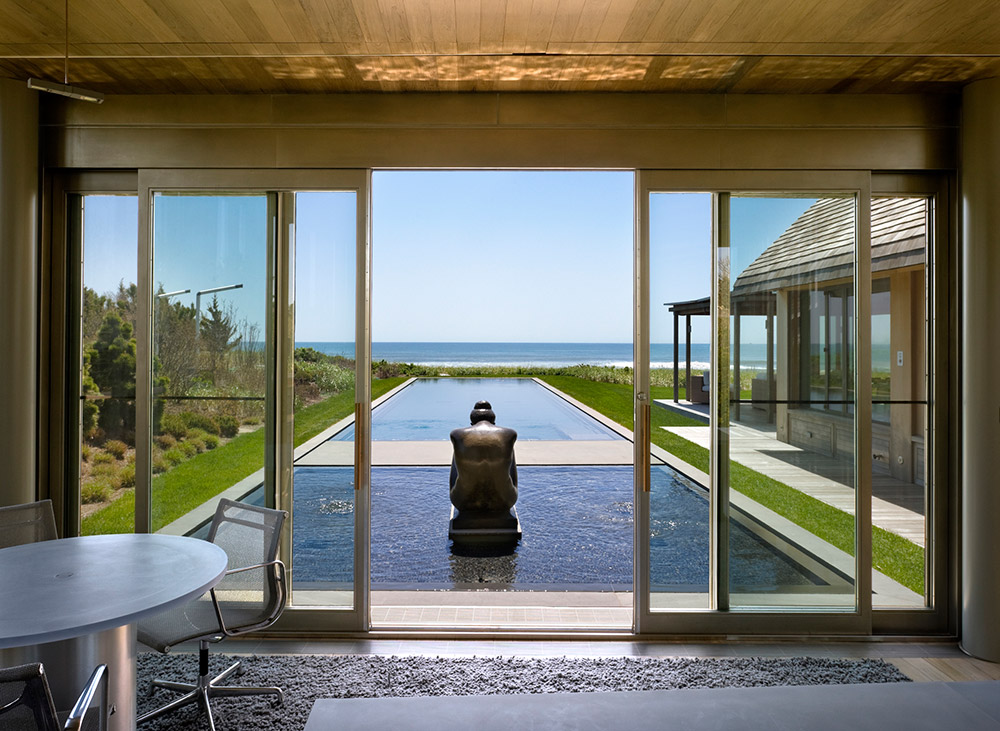
New research supports measureable, positive impacts of biophilic design on health, strengthening the empirical evidence for the human-nature connection and raising its priority level within both design research and design practice; however, little guidance for implementation exists. This paper is intended to help close the gap between current research and implementation. The intended audiences of this publication are interior designers, architects, landscape architects, urban designers, planners, health professionals, employers and developers, as well as anyone wanting to better understand the patterns of biophilia.
14 Patterns of Biophilic Design
- Nature in the Space Patterns
- 1. Visual Connection with Nature
- 2. Non-Visual Connection with Nature
- 3. Non-Rhythmic Sensory Stimuli
- 4. Thermal & Airflow Variability
- 5. Presence of Water
- 6. Dynamic & Diffuse Light
- 7. Connection with Natural Systems
- Natural Analogues Patterns
- 8. Biomorphic Forms & Patterns
- 9. Material Connection with Nature
- 10. Complexity & Order
- Nature of the Space Patterns
- 11. Prospect
- 12. Refuge
- 13. Mystery
- 14. Risk/Peril
This paper puts biophilic design in context with architectural history, health sciences and current architectural practices, and briefly touches on key implementation considerations, then presents biophilic design patterns. The patterns have been developed through extensive interdisciplinary research and are supported by empirical evidence and the work of Christopher Alexander, Judith Heerwagen, Rachel and Stephen Kaplan, Stephen Kellert, Roger Ulrich, and many others. Over 500 publications on biophilic responses have been mined to uncover patterns useful to designers of the built environment. These 14 patterns have a wide range of applications for both interior and exterior environments, and are meant to be flexible and adaptive, allowing for project-appropriate implementation:
Finally, this paper discusses these patterns in a general sense for the purpose of addressing universal issues of human health and well-being (e.g., stress, visual acuity, hormone balance, creativity) within the built environment, rather than program-based or sector-specific space types (e.g., health care facility waiting rooms, elementary school classrooms, or storefront pedestrian promenades). As such, the focus is on patterns in nature known, suggested or theorized to mitigate common stressors or enhance desirable qualities that can be applied across various sectors and scales.
We hope this paper presents the foundation necessary for thinking more critically about the human connection with nature and how biophilic design patterns can be used as a tool for improving health and well-being in the built environment.
2. Biophilia in Context
link to this section
" 'This is what I prayed for,' wrote the Roman poet Horace. 'A piece of land – not so very big, with a garden and, near the house, a spring that never fails, and a bit of wood to round it off.'
Those words were set down more than 2000 years ago, around 30 B.C. It is easy to understand the emotion prompting them; we still recognize what Horace meant by a rural garden, a place to take refuge, as he did, from the irritations of city life."
2.1 Rediscovering the Intuitively Obvious
link to this sectionNature themes can be found in the earliest human structures: Stylized animals characteristic of the Neolithic Göbekli Tepe; the Egyptian sphinx, or the acanthus leaves adorning Greek temples and their Vitruvian origin story; from the primitive hut to the delicate, leafy filigrees of Rococo design. Representations of animals and plants have long been used for decorative and symbolic ornamentation. Beyond representation, cultures around the world have long brought nature into homes and public spaces. Classic examples include the garden courtyards of the Alhambra in Spain, porcelain fish bowls in ancient China, the aviary in Teotihuacan (ancient Mexico City), bonsai in Japanese homes, papyrus ponds in the homes of Egyptian nobles, the cottage garden in medieval Germany, or the elusive hanging gardens of Babylon.
The consistency of natural themes in historic structures and places suggests that biophilic design is not a new phenomenon; rather, as a field of applied science, it is the codification of history, human intuition and neural sciences showing that connections with nature are vital to maintaining a healthful and vibrant existence as an urban species.
Prior to and even after the Industrial Revolution, the vast majority of humans lived an agrarian existence, living much of their lives among nature. American landscape architect Frederick Law Olmsted argued in 1865, that "…the enjoyment of scenery employs the mind without fatigue and yet exercises it, tranquilizes it and yet enlivens it; and thus, through the influence of the mind over the body, gives the effect of refreshing rest and reinvigoration to the whole system" (2. Olmsted, 1865 ). As urban populations grew in the 19th Century, reformers became increasingly concerned with health and sanitation issues such as fire hazards and dysentery. The creation of large public parks became a campaign to improve the health and reduce the stress of urban living.
Artists and designers of the Victorian era, such as influential English painter and art critic, John Ruskin, pushed back against what they saw as the dehumanizing experience of industrial cities. They argued for objects and buildings that reflected the hand of the craftsman and drew from nature for inspiration. In the design of the Science Museum at Oxford, Ruskin is said to have told the masons to use the surrounding countryside for inspiration, and the results can be seen in the inclusion of hand-carved flowers and plants adorning the museum (3. Kellert & Finnegan, 2011 ).
Western attitudes toward nature were shifting in the mid-19th Century; natural landscapes became valid art subjects, as seen in the Hudson River School and the Barbizon School in France. Going to the mountains or seashore for recreation was becoming a growing trend; Winter gardens and conservatories become requisites of wealthy homes in Europe and the United States. Henry David Thoreau built a cabin by Walden Pond in Concord, Massachusetts from which he wrote treatises on a simpler life, connected to nature, which still resonate in the American consciousness. In hospital design, sunlight and a view to nature was believed to be important, as can be seen at St. Elizabeth's in Washington, D.C. Designed in the 1850s to the concepts of Dr. Thomas Kirkbride, who "…believed that the beautiful setting…restored patients to a more natural balance of the senses" (4. Sternberg, 2009 ).
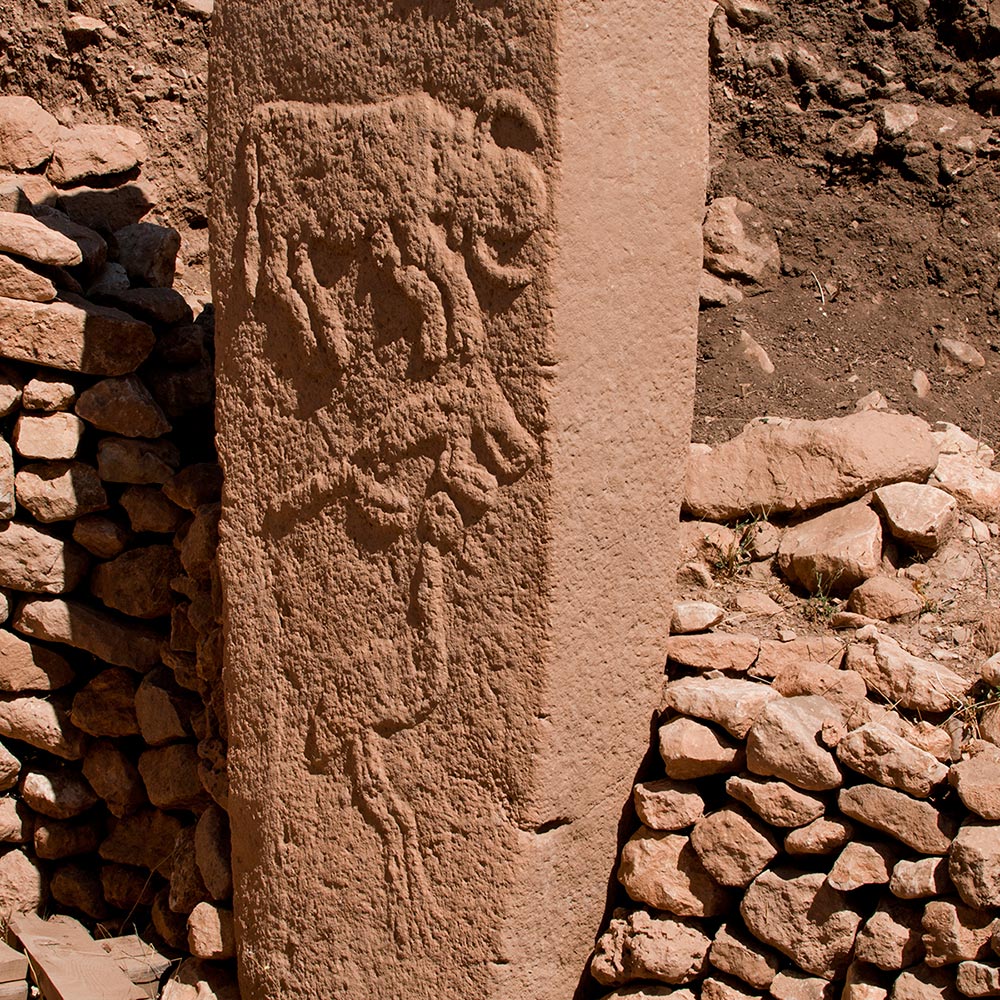
Animal stone carvings at the ancient Göbekli Tepe.
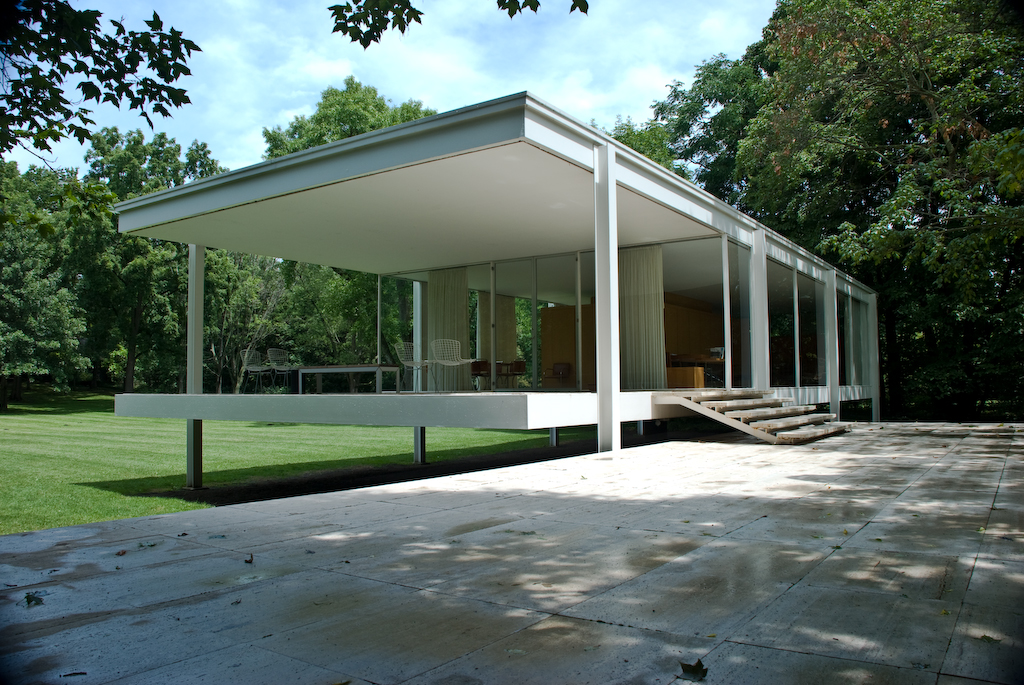
The play of volumes and glass in Mies Van Der Rohe's Farnsworth House.
Inspiration from nature was in full view in the Art Nouveau designs of the late 19th Century. Architect Victor Horta's exuberant plant tendrils lacing through buildings in Belgium, the lush flowers that are Louis Comfort Tiffany lamps, and the explicitly biomorphic forms of Antonio Gaudí's buildings all remain strong examples. In Chicago, Louis Sullivan created elaborate ornamentation with leaves and cornices that represent tree branches. His protégé, Frank Lloyd Wright, is part of the group that launched The Prairie School.
Wright abstracted prairie flowers and plants for his art glass windows and ornamentation. Like many in the Craftsman movement, Wright used the grain of wood and texture of brick and stone as a decorative element. Wright also opened up interiors to flow through houses in ways that had not been done before, creating prospect views balanced with intimate refuges. His later designs sometimes include exhilarating spaces, like the balcony cantilevering out over the waterfall at Fallingwater.
European Modernists stripped much ornamentation from their buildings, but, like Wright, used wood grain and the veining of stone as decorative elements and were equally concerned with exploring the relationship of interior to exterior. Ludwig Mies van der Rohe's Barcelona Pavilion (built 1929) pushed that concept in the play of volumes and glass. Later, his Farnsworth House (built 1951) defined interior and exterior much more literally, by segregating the elements from the visual connection to nature.
Le Corbusier's Cité Radiant (unbuilt 1924) may have resulted in disastrous urban designs, but by putting towers in a park surrounded by grass and trees, he was trying to provide city dwellers with a connection to nature. As the International Style took root, it spread glass buildings everywhere; unfortunately, the buildings, and particularly the interiors of commercial buildings, increasingly disconnected people from nature.
The term 'biophilia' was first coined by social psychologist Eric Fromm (5. The Heart of Man, 1964 ) and later popularized by biologist Edward Wilson (Biophilia, 1984). The sundry denotations – which have evolved from within the fields of biology and psychology, and been adapted to the fields of neuroscience, endocrinology, architecture and beyond – all relate back to the desire for a (re)connection with nature and natural systems. That we should be genetically predisposed to prefer certain types of nature and natural scenery, specifically the savanna, was posited by Gordon Orians and Judith Heerwagen (6. Savanna Hypothesis, 1986 ), and could theoretically be a contributing motivation for moving to the suburbs, with the suburban lawn being a savanna for everyone.
With the emergence of the green building movement in the early 1990s, linkages were made between improved environmental quality and worker productivity (7. Browning & Romm, 1994 ). While the financial gains due to productivity improvements were considered significant, productivity was identified as a placeholder for health and well-being, which have even broader impact. The healing power of a connection with nature was established by Roger Ulrich's landmark study comparing recovery rates of patients with and without a view to nature (8. Ulrich, 1984 ). An experiment at a new Herman Miller manufacturing facility, designed by William McDonough + Partners in the 1990s, was one of the first to specifically frame the mechanism for gains in productivity to connecting building occupants to nature – phylogenetic or, more familiarly, biophilic design (9. Heerwagen & Hase, 2001 ).
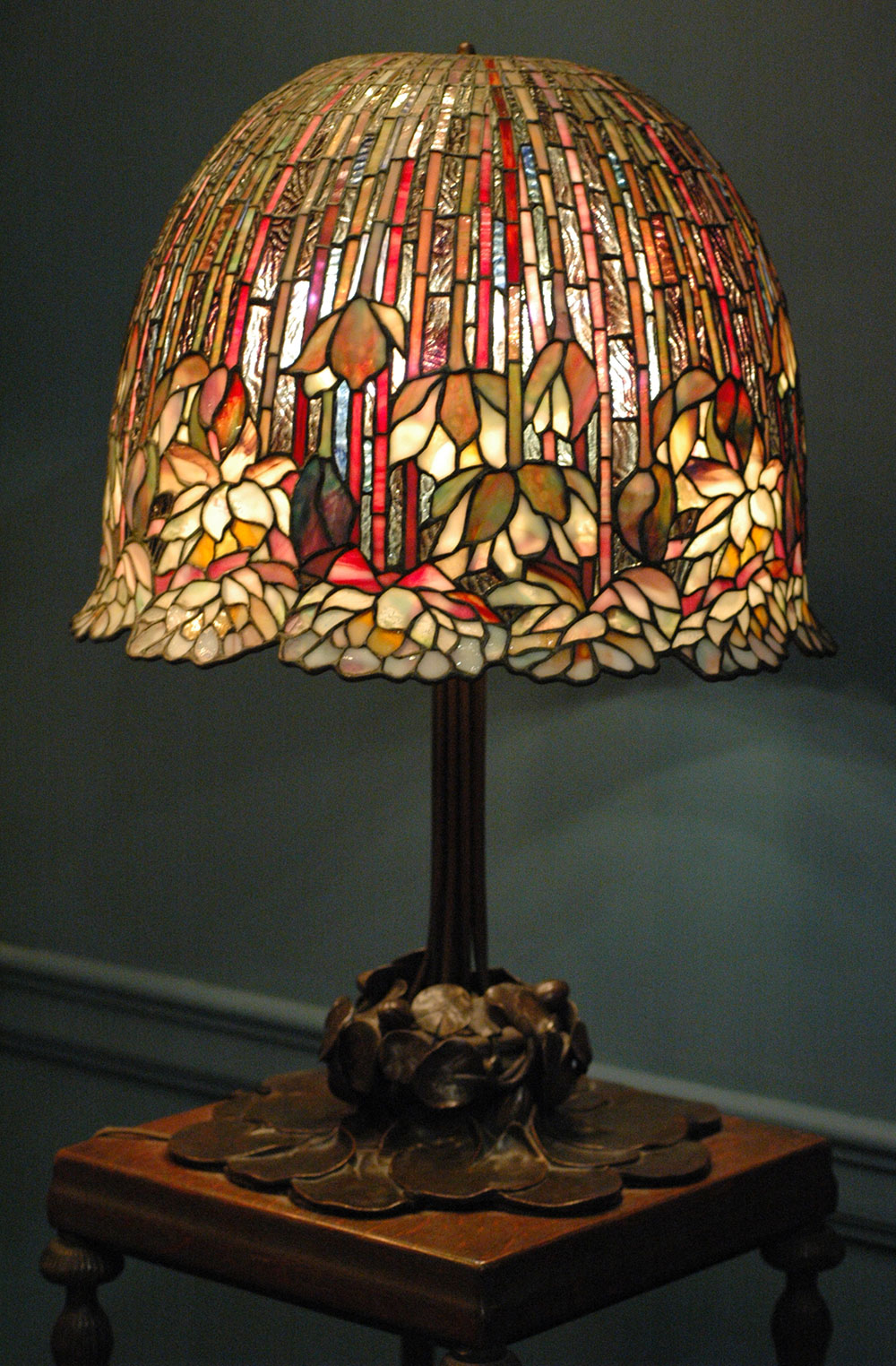
A Louis Comfort Tiffany Lamp with flower pattern design.
The translation of biophilia as a hypothesis into design of the built environment was the topic of a 2004 conference and subsequent book on biophilic design (10. Eds., Kellert, Heerwagen & Mador, 2008 ) in which Stephen Kellert identified more than 70 different mechanisms for engendering a biophilic experience, and contributing authors William Browning and Jenifer Seal-Cramer outlined three classifications of user experience: Nature in the Space, Natural Analogues, and Nature of the Space.
The last decade has seen a steady growth in work around and the intersections of neuroscience and architecture, both in research and in practice; even green building standards have begun to incorporate biophilia, predominantly for its contribution to indoor environmental quality and connection to place. Popular texts, such as Last Child in the Woods (11. Louv, 2008 ), Healing Spaces (12. Sternberg, 2009 ), The Shape of Green (13. Hosey, 2012 ), Your Brain on Nature (14. Selhub & Logan, 2012 ), and "The Economics of Biophilia" (15. Terrapin Bright Green, 2012 ), are bringing the conversation mainstream, helping the public grapple with modern society's dependency on technology and persistent disconnect with nature. Most recently, biophilic design is being championed as a complementary strategy for addressing workplace stress, student performance, patient recovery, community cohesiveness and other familiar challenges to health and overall well-being.
2.2 Defining Nature
link to this sectionViews of what constitutes natural, nature, wild, or beautiful greatly vary. While we have no intention of formalizing an explicit definition, some articulation of what we mean by 'nature' will help give context to practitioners of biophilic design. Simply put, there are two extreme connotations of nature. One is that nature is only that which can be classified as a living organism unaffected by anthropogenic impacts on the environment – a narrow perspective of nature (reminiscent of conventional hands-off environmental preservation) that ultimately no longer exists because nearly everything on Earth has been and will continue to be impacted at least indirectly by humans. Additionally, this idea of nature essentially excludes everything from the sun and moon, your pet fish Nemo, home gardens and urban parks, to humans and the billions of living organisms that make up the biome of the human gut.
Alternatively, it could be argued that everything, including all that humans design and make, is natural and a part of nature because they are each extensions of our phenotype. This perspective inevitably includes everything from paperback books and plastic chairs, to chlorinated swimming pools and asphalt roadways.
As a middle ground, for the purpose of understanding the context of Biophilic Design, we are defining nature as living organisms and non-living components of an ecosystem – inclusive of everything from the sun and moon and seasonal arroyos, to managed forests and urban raingardens, to Nemo's fishbowl habitat.
For added clarity, we are making the distinction that, in the context of health and well-being in the built environment, most nature in modern society is designed, whether deliberately (for function or aesthetic), haphazardly (for navigability or access to resources) or passively (through neglect or hands-off preservation); thus, we refer back to humankind's proclivity for savanna landscapes. Humans create savanna analogues all the time. As designed ecosystems, some, such as the high canopy forests with floral undergrowth maintained by the annual burning practices of the Ojibwe people of North America, are biodiverse, vibrant and ecologically healthy. Others, such as suburban lawns and golf courses, are chemical dependent monocultures; while beautiful, they are not biodiverse, ecologically healthy or resilient.
The key issue is that some designed environments are well-adapted (supporting long term life) and some are not. So while golf courses and suburban lawns may be a savanna analogue, in many cases they require intense inputs of water and fertilizer and thus are unfortunately unsustainable design practices.
2.3 Nature-Design Relationships
link to this sectionBiophilic design can be organized into three categories – Nature in the Space, Natural Analogues, and Nature of the Space – providing a framework for understanding and enabling thoughtful incorporation of a rich diversity of strategies into the built environment.
Nature in the Space
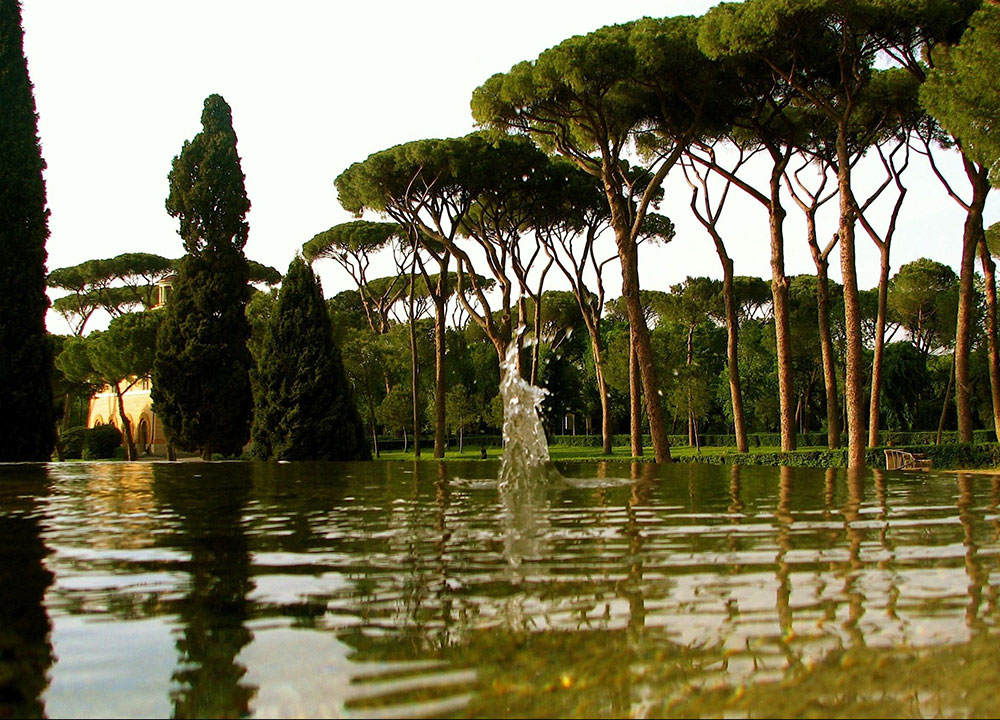
Canopy trees and water features of the Vatican City gardens.
Nature in the Space addresses the direct, physical and ephemeral presence of nature in a space or place. This includes plant life, water and animals, as well as breezes, sounds, scents and other natural elements. Common examples include potted plants, flowerbeds, bird feeders, butterfly gardens, water features, fountains, aquariums, courtyard gardens and green walls or vegetated roofs. The strongest Nature in the Space experiences are achieved through the creation of meaningful, direct connections with these natural elements, particularly through diversity, movement and multi-sensory interactions.
Nature in the Space encompasses seven biophilic design patterns:
- Visual Connection with Nature. A view to elements of nature, living systems and natural processes.
- Non-Visual Connection with Nature. Auditory, haptic, olfactory, or gustatory stimuli that engender a deliberate and positive reference to nature, living systems or natural processes.
- Non-Rhythmic Sensory Stimuli. Stochastic and ephemeral connections with nature that may be analyzed statistically but may not be predicted precisely.
- Thermal & Airflow Variability. Subtle changes in air temperature, relative humidity, airflow across the skin, and surface temperatures that mimic natural environments.
- Presence of Water. A condition that enhances the experience of a place through seeing, hearing or touching water.
- Dynamic & Diffuse Light. Leverages varying intensities of light and shadow that change over time to create conditions that occur in nature.
- Connection with Natural Systems. Awareness of natural processes, especially seasonal and temporal changes characteristic of a healthy ecosystem.
Natural Analogues
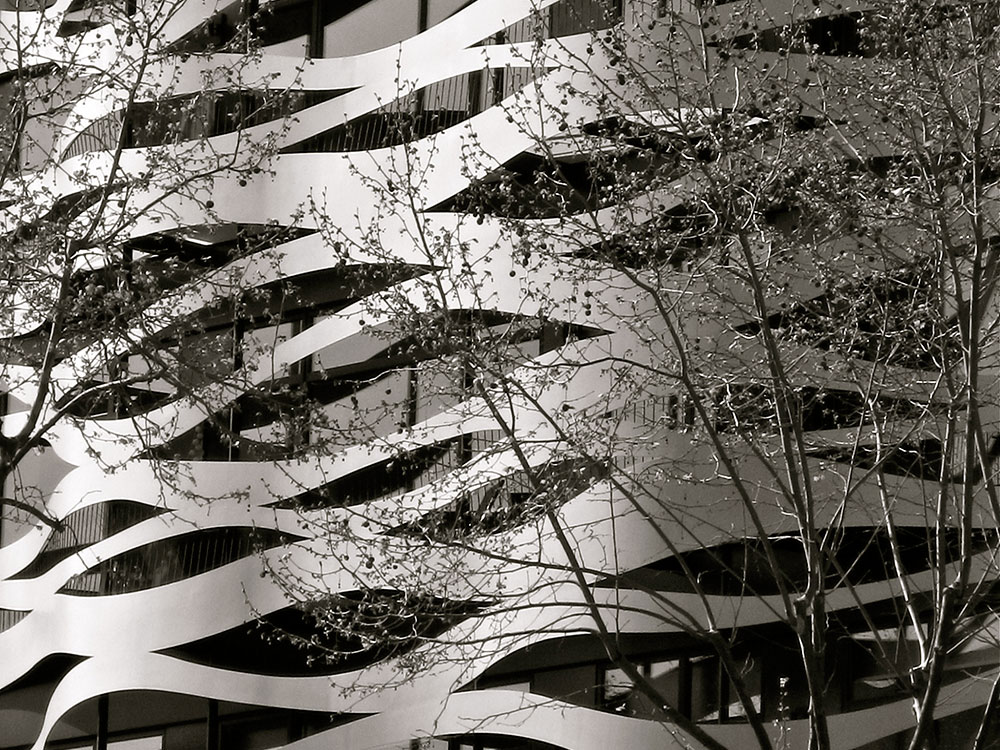
Façade renovation of Suites Avenue Aparthotel by Toyo Ito, Barcelona, Spain, is biomorphic in form, while enhancing the Dynamic & Diffuse light and shadows filtering to the interior space.
Natural Analogues addresses organic, non-living and indirect evocations of nature. Objects, materials, colors, shapes, sequences and patterns found in nature, manifest as artwork, ornamentation, furniture, décor, and textiles in the built environment. Mimicry of shells and leaves, furniture with organic shapes, and natural materials that have been processed or extensively altered (e.g., wood planks, granite tabletops), each provide an indirect connection with nature: while they are real, they are only analogous of the items in their 'natural' state. The strongest Natural Analogue experiences are achieved by providing information richness in an organized and sometimes evolving manner.
Natural Analogues encompasses three patterns of biophilic design:
- Biomorphic Forms & Patterns. Symbolic references to contoured, patterned, textured or numerical arrangements that persist in nature.
- Material Connection with Nature. Materials and elements from nature that, through minimal processing, reflect the local ecology or geology and create a distinct sense of place.
- Complexity & Order. Rich sensory information that adheres to a spatial hierarchy similar to those encountered in nature.
Nature of the Space

Stepping stones at the Fort Worth Water Garden, Fort Worth, Texas.
Nature of the Space addresses spatial configurations in nature. This includes our innate and learned desire to be able to see beyond our immediate surroundings, our fascination with the slightly dangerous or unknown; obscured views and revelatory moments; and sometimes even phobia-inducing properties when they include a trusted element of safety. The strongest Nature of the Space experiences are achieved through the creation of deliberate and engaging spatial configurations commingled with patterns of Nature in the Space and Natural Analogues.
Nature of the Space encompasses four biophilic design patterns:
- Prospect. An unimpeded view over a distance, for surveillance and planning.
- Refuge. A place for withdrawal from environmental conditions or the main flow of activity, in which the individual is protected from behind and overhead.
- Mystery. The promise of more information, achieved through partially obscured views or other sensory devices that entice the individual to travel deeper into the environment.
- Risk/Peril. An identifiable threat coupled with a reliable safeguard.
Periodically throughout this paper, these patterns will be referred to in shorthand by their number 1 to 14 for quick reference. For instance, Presence of Water will appear as [P5] and Prospect will appear as [P11].
2.4 Nature-Health Relationships
Stress & Well-being
For an overview on "well-being" – definitions, metrics, research – see The Centers for Disease Control and Prevention (CDC).
For a background on meanings of stress, see "Mazes and Labyrinths" in Healing Spaces (16. Sternberg, 2009, pp95-124 ).
For a more extensive non-technical discussion on the science of nature's influence on health, happiness and vitality, see Your Brain on Nature (17. Selhub & Logan, 2012 ).
For a more technical introduction to the hormones and neurotransmitters that govern our mind-body systems, see Principles of Neural Science (18. Kandel et al., 2013 ).
Much of the evidence for biophilia can be linked to research in one or more of three overarching mind-body systems – cognitive, psychological and physiological – that have been explored and verified to varying degrees, in laboratory or field studies, to help explain how people's health and well-being are impacted by their environment. To familiarize the reader with these nature-health relationships, these mind-body systems are discussed here in the briefest sense, and are supported with a table of familiar hormones and neurotransmitters, environmental stressors, and biophilic design strategies.
Cognitive Functionality and Performance
Cognitive functioning encompasses our mental agility and memory, and our ability to think, learn and output either logically or creatively. For instance, directed attention is required for many repetitive tasks, such as routine paperwork, reading and performing calculations or analysis, as well as for operating in highly stimulating environments, as when crossing busy streets. Directed attention is energy intensive, and over time can result in mental fatigue and depleted cognitive resources (e.g.,19. Kellert et al., 2008 ; 20. van den Berg et al., 2007 ).
Strong or routine connections with nature can provide opportunities for mental restoration, during which time our higher cognitive functions can sometimes take a break. As a result, our capacity for performing focused tasks is greater than someone with fatigued cognitive resources.
Psychological Health and Well-being
Psychological responses encompass our adaptability, alertness, attention, concentration, and emotion and mood. This includes responses to nature that impact restoration and stress management. For instance, empirical studies have reported that experiences of natural environments provide greater emotional restoration, with lower instances of tension, anxiety, anger, fatigue, confusion and total mood disturbance than urban environments with limited characteristics of nature (e.g., 21. Alcock et al., 2013 ; 22. Barton & Pretty, 2010 ; 23. Hartig et al., 2003 ; 24. Hartig et al., 1991 ).
Psychological responses can be learned or hereditary, with past experiences, cultural constructs and social norms playing a significant role in the psychological response mechanism.
Physiological Health and Well-being
Physiological responses encompass our aural, musculoskeletal, respiratory, circadian systems and overall physical comfort. Physiological responses triggered by connections with nature include relaxation of muscles, as well as lowering of diastolic blood pressure and stress hormone (i.e., cortisol) levels in the blood stream (e.g., 25. Park et al., 2009 ). Short term stress that increases heart rate and stress hormone levels, such as from encountering an unknown but complex and information-rich space, or looking over a banister to 8 stories below, is suggested to be beneficial to regulating physiological health (26. Kandel et al., 2013 ).
The physiological system needs to be tested regularly, but only enough for the body to remain resilient and adaptive. Physiological responses to environmental stressors can be buffered through design, allowing for the restoration of bodily resources before system damage occurs (27. Steg, 2007 ).
Table 1. Biophilic Design Patterns & Biological Responses
The table illustrates the functions of each of the 14 Patterns in supporting stress reduction, cognitive performance, emotion and mood enhancement and the human body. Patterns that are supported by more rigorous empirical data are marked with up to three asterisks (***), indicating that the quantity and quality of available peer-reviewed evidence is robust and the potential for impact is great, and no asterisk indicates that there is minimal research to support the biological relationship between health and design, but the anecdotal information is compelling and adequate for hypothesizing its potential impact and importance as a unique pattern.
| 14 Patterns | * | Stress Reduction | Cognitive Performance | Emotion, Mood & Preference |
|---|---|---|---|---|
| Nature in the Space | ||||
| Visual Connection with Nature | * * * | Lowered blood pressure and heart rate (28. Brown, Barton & Gladwell, 2013 ; 29. van den Berg, Hartig, & Staats, 2007 ; 30. Tsunetsugu & Miyazaki, 2005 ) | Improved mental engagement/ attentiveness (31. Biederman & Vessel, 2006 ) | Positively impacted attitude and overall happiness (32. Barton & Pretty, 2010 ) |
| Non-Visual Connection with Nature | * * | Reduced systolic blood pressure and stress hormones (33. Park, Tsunetsugu, Kasetani et al., 2009 ; 34. Hartig, Evans, Jamner et al., 2003 ; 35. Orsega-Smith, Mowen, Payne et al., 2004 ; 36. Ulrich, Simons, Losito et al., 1991 ) | Positively impacted cognitive performance (37. Mehta, Zhu & Cheema, 2012 ; 38. Ljungberg, Neely, & Lundström, 2004 ) | Perceived improvements in mental health and tranquility (39. Li, Kobayashi, Inagaki et al., 2012 ; 40. Jahncke, et al., 2011 ; 41. Tsunetsugu, Park, & Miyazaki, 2010 ; 42. Kim, Ren, & Fielding, 2007 ; 43. Stigsdotter & Grahn, 2003 ) |
| Non-Rhythmic Sensory Stimuli | * * | Positively impacted heart rate, systolic blood pressure and sympathetic nervous system activity (44. Li, 2009 ; 45. Park et al, 2008 ; 46. Kahn et al., 2008 ; 47. Beauchamp, et al., 2003 ; 48. Ulrich et al., 1991 ) | Observed and quantified behavioral measures of attention and exploration (49. Windhager et al., 2011 ) | |
| Thermal & Airflow Variability | * * | Positively impacted comfort, well-being and productivity (50. Heerwagen, 2006 ; 51. Tham & Willem, 2005 ; 52. Wigö, 2005 ) | Positively impacted concentration(53. Hartig et al., 2003 ; 54. Hartig et al., 1991 ; 55. R. Kaplan & Kaplan, 1989 ) | Improved perception of temporal and spatial pleasure (alliesthesia)(56. Parkinson, de Dear & Candido, 2012 ; 57. Zhang, Arens, Huizenga & Han, 2010 ; 58. Arens, Zhang & Huizenga, 2006 ; 59. Zhang, 2003 ; 60. de Dear & Brager, 2002 ; 61. Heschong, 1979 ) |
| Presence of Water | * * | Reduced stress, increased feelings of tranquility, lower heart rate and blood pressure(62. Alvarsson, Wiens, & Nilsson, 2010 ; 63. Pheasant, Fisher, Watts et al., 2010 ; 64. Biederman & Vessel, 2006 ) | Improved concentration and memory restoration(65. Alvarsson et al., 2010 ; 66. Biederman & Vessel, 2006 ) Enhanced perception and psychological responsiveness(67. Alvarsson et al., 2010 ; 68. Hunter et al., 2010 ) | Observed preferences and positive emotional responses(69. Windhager, 2011 ; 70. Barton & Pretty, 2010 ; 71. White, Smith, Humphryes et al., 2010 ; 72. Karmanov & Hamel, 2008 ; 73. Biederman & Vessel, 2006 ; 74. Heerwagen & Orians, 1993 ; 75. Ruso & Atzwanger, 2003 ; 76. Ulrich, 1983 ) |
| Dynamic & Diffuse Light | * * | Positively impacted circadian system functioning(77. Figueiro, Brons, Plitnick et al., 2011 ; 78. Beckett & Roden, 2009 )Increased visual comfort(79. Elyezadi, 2012 ; 80. Kim & Kim, 2007 ) | ||
| Connection with Natural Systems | Enhanced positive health responses; Shifted perception of environment(81. Kellert et al., 2008 ) | |||
| Natural Analogues | ||||
| Biomorphic Forms & Patterns | * | Observed view preference(82. Vessel, 2012 ; 83. Joye, 2007 ) | ||
| Material Connection with Nature | Decreased diastolic blood pressure (84. Tsunetsugu, Miyazaki & Sato, 2007 )Improved creative performance (85. Lichtenfeld et al., 2012 ) | Improved comfort (86. Tsunetsugu, Miyazaki & Sato, 2007 ) | ||
| Complexity & Order | * * | Positively impacted perceptual and physiological stress responses (87. Salingaros, 2012 ; 88. Joye, 2007 ; 89. Taylor, 2006 ; 90. S. Kaplan, 1988 ) | Observed view preference (91. Salingaros, 2012 ; 92. Hägerhäll, Laike, Taylor et al., 2008 ; 93. Hägerhäll, Purcella, & Taylor, 2004 ; 94. Taylor, 2006 ) | |
| Nature of the Space | ||||
| Prospect | * * * | Reduced stress (95. Grahn & Stigsdotter, 2010 ) | Reduced boredom, irritation, fatigue (96. Clearwater & Coss, 1991 ) | Improved comfort and perceived safety (97. Herzog & Bryce, 2007 ; 98. Wang & Taylor, 2006 ; 99. Petherick, 2000 ) |
| Refuge | * * * | Improved concentration, attention and perception of safety (100. Grahn & Stigsdotter, 2010 ; 101. Wang & Taylor, 2006 ; 102. Petherick, 2000 ; 103. Ulrich et al., 1993 ) | ||
| Mystery | * * | Induced strong pleasure response (104. Biederman, 2011 ; 105. Salimpoor, Benovoy, Larcher et al., 2011 ; 106. Ikemi, 2005 ; 107. Blood & Zatorre, 2001 ) | ||
| Risk/Peril | * | Resulted in strong dopamine or pleasure responses (108. Kohno et al., 2013 ; 109. Wang & Tsien, 2011 ; 110. Zald et al., 2008 ) | ||
3. Design Considerations
link to this section
"There is rarely a solution that is universal. Rather, the 'correct' solution, in our view, is one that is locally appropriate and responsive to the situation at hand."
3.1 What is Good Biophilic Design?
Biophilic design is the designing for people as a biological organism, respecting the mind-body systems as indicators of health and well-being in the context of what is locally appropriate and responsive. Good biophilic design draws from influential perspectives – health conditions, socio-cultural norms and expectations, past experiences, frequency and duration of the user experience, the many speeds at which it may be encountered, and user perception and processing of the experience – to create spaces that are inspirational, restorative, and healthy, as well as integrative with the functionality of the place and the (urban) ecosystem to which it is applied. Above all, biophilic design must nurture a love of place.
3.2 Planning for Implementation
Increasingly dense urban environments, coupled with rising land values, elevate the importance of biophilic design across a spatial continuum from new and existing buildings, to parks and streetscapes and to campus, urban and regional planning. Each context supports a platform for myriad opportunities for integrative biophilic design, and mainstreaming healthy building practices for people and society. Discussed here in brief are some key perspectives that may help focus the planning and design processes.
Identifying desired responses and outcomes
It is vital for a designer to understand a project's design intent – what are the health or performance priorities of the intended users? To identify design strategies and interventions that restore or enhance well-being, project teams should understand the health baseline or performance needs of the target population. One approach is to ask: what is the most biophilic space we can conceivably design? Another is to ask: how can biophilic design improve performance metrics already used by the client (e.g., company executives, school board, city officials), such as absenteeism, perceived comfort, health care claims, asthma, ticket sales, or test scores.
As many biological responses to design occur together (e.g., reducing physiological indicators of stress and improving overall mood), and there are countless combinations of design patterns and interventions, understanding health related priorities will help focus the design process. Health outcomes associated with biophilic spaces are of interest to building and portfolio managers and human resources administrators, because they inform long term design and measurement best practices, and to planners, policy makers and others because they inform public health policy and urban planning.
Design strategies and interventions
Biophilic design patterns are flexible and replicable strategies for enhancing the user experience that can be implemented under a range of circumstances. Just as lighting design for a classroom will be different than for a spa or home library, biophilic design interventions are based on the needs of a specific population in a particular space, and are likely to be developed from a series of evidence-based biophilic design patterns, ideally with a degree of monitoring and evaluation for efficacy.
For example, a project team may embrace the Visual Connection with Nature pattern to enhance the workplace experience for a series of interior fit-outs for a portfolio of offices. The strategy would be to improve views and bring plants into the space; the interventions may include installing a green wall, orienting desks to maximize views to outdoors, and initiating an employee stipend for desk plants. The detail, location, and the extent to which each of these interventions is implemented will differ for each of the offices in the portfolio.
A project team charged with reducing stress among emergency room nurses at the local hospital may intervene by replacing the abstract art with landscape paintings on the walls of the staffroom and installing a small garden and seating area in the adjacent interior courtyard. While this project also uses the Visual Connection with Nature pattern, the selected interventions specifically target stress reduction for emergency room nurses based on a shared space they utilize routinely.
Diversity of design strategies
Patterns in combination tend to increase the likelihood of health benefits of a space. Incorporating a diverse range of design strategies can accommodate the needs of various user groups from differing cultures and demographics and create an environment that is psycho-physiologically and cognitively restorative. For instance, vegetated spaces can improve an individual's self-esteem and mood, while the presence of water can have a relaxing effect. Adding multiple biophilic strategies for the sake of diversity may backfire unless they are integrative and supporting a unified design intent.
Quality vs. quantity of intervention
When planning for implementation, common questions recur, such as how much is enough and what makes a good design great. A high quality intervention may be defined by the richness of content, user accessibility and, as mentioned above, diversity of strategies. A single high quality intervention can be more effective and have greater restorative potential than several low quality interventions. Climate, cost and other variables may influence or limit feasibility of certain interventions, but should not be considered an obstacle to achieving a high quality application. For example, multiple instances of Prospect with a shallow to moderate depth of field and limited information in the viewshed may not be as effective (at prompting the desired response) as a single powerful instance of Prospect with a moderate to high depth of field and an information-rich viewshed.
Duration of exposure and frequency of access
Identifying the most appropriate duration of exposure to a pattern, or combination of patterns, can be difficult. The ideal exposure time is likely dependent upon the user and desired effect, but as a general guideline, empirical evidence shows that positive emotions, mental restoration and other benefits can occur in as little as 5 to 20 minutes of immersion in nature (111. Brown, Barton & Gladwell, 2013 ; 112. Barton & Pretty, 2010 ; 113. Tsunetsugu & Miyazaki, 2005 ).
When a long duration of exposure is not possible or desired, positioning biophilic design interventions along paths that channel high levels of foot traffic will help improve frequency of access. Consider too that micro-restorative experiences – brief sensory interactions with nature that promote a sense of well-being – while often designed in response to space-restriction, are more readily implementable, replicable and often more accessible than larger interventions; frequent exposure to these small interventions may contribute to a compounded restoration response.
Questions abound on matters of duration of exposure and frequency of access: How persistent is mental restoration over different terms of exposure to nature? Do the improvements continue incrementally with more exposure, or do they plateau? What combinations of design patterns can help optimize a biophilic experience? We hope these questions and others will be explored as research continues on the intersections of neuroscience and design (114. Ryan et al., 2014 ).
3.3 Locally Appropriate Design
No two places are the same; this presents both challenges and opportunities for creativity in the application of biophilic design patterns. Discussed here are some key considerations that may help frame, prioritize, or influence decision making in the design process.
Climate, ecology and the vernacular
Historically, humans have built shelters from locally available materials that reflected the regional ecology; form and function were in response to the topography and climate. Known as vernacular architecture, these buildings and constructed landscapes connect to where they inhabit. Use of local timber, climate responsive design and xeriscaping – using native, drought tolerant plants to create landscape designs that resemble the climate of the surrounding landscape – can each be effective strategies in designing for a resilient, biophilic experience.
Whether rural or urban, not all natural or tempered environments are 'green' in color, nor should they be. Desert species and terrain can be equally important in reinforcing a biophilic connection to place. Some habitats may engender a stronger positive response than others, but a biodiverse savanna-like scene will most likely be preferred over an area abundant yet trackless sand desert, the open ocean, or a dark forest.
Character and density: Rural, suburban and urban environments
In rural environments, human-nature interactions are abundant, and this regular exposure to nature has restorative qualities that we perhaps take for granted. Suburban settings are typically rife with intuitively applied biophilic design; the suburban yard with shade trees, grass, low shrubs, and beds of flowers is essentially an analogue of the African savanna. Porches and balconies offer more than just quaintness and real estate value; many suburban homes and urban rowhouses are raised 18 inches or more, creating a Prospect-Refuge condition with views from windows, stoops and porches. The potential human health benefits are undervalued in high-density settings where residential towers with balconies are both limited and only available to high-paying tenants.
Land in urban environments is limited and at a premium, so it may be unrealistic to replicate features more suitable to a rural environment in terms of scale or abundance. As such, biophilic design strategies will differ depending on the local political climate, zoning, geography, land availability and ownership. For instance, San Francisco, with its high-density urban form, implemented a 'parklet' system, whereby temporary pop-up parks occupy parking spaces for limited periods of time (116. see City of San Francisco, 2013 ). In the narrow streets of Vienna, Austria, restaurants rent parking spaces for the entire summer and set up tables and temporary landscaping to provide outdoor dining. This brings nature into the urban core and within walking distance to a greater number of people, opening up the possibility for micro-restorative experiences.
A different approach to integrating natural systems with urban systems is exhibited in Singapore's 'Skyrise Greenery' program. Given the high levels of development in tropical Singapore over the last 25 years – a period which saw the country's populations grow by 2 million people – the government offered an incentive program to offset the loss of habitat, increase interaction with natural stimuli, and create the 'City within a Garden'. This incentive program offers up to 75% of the costs for installing living roofs and walls (exterior and interior) for new constructions (117. Beatley, 2012 ). What's important is that the strategy be integrative and appropriate to the character and density of the place, and not just another word for ecosystem restoration that does not reflect the human biological relationship with nature.
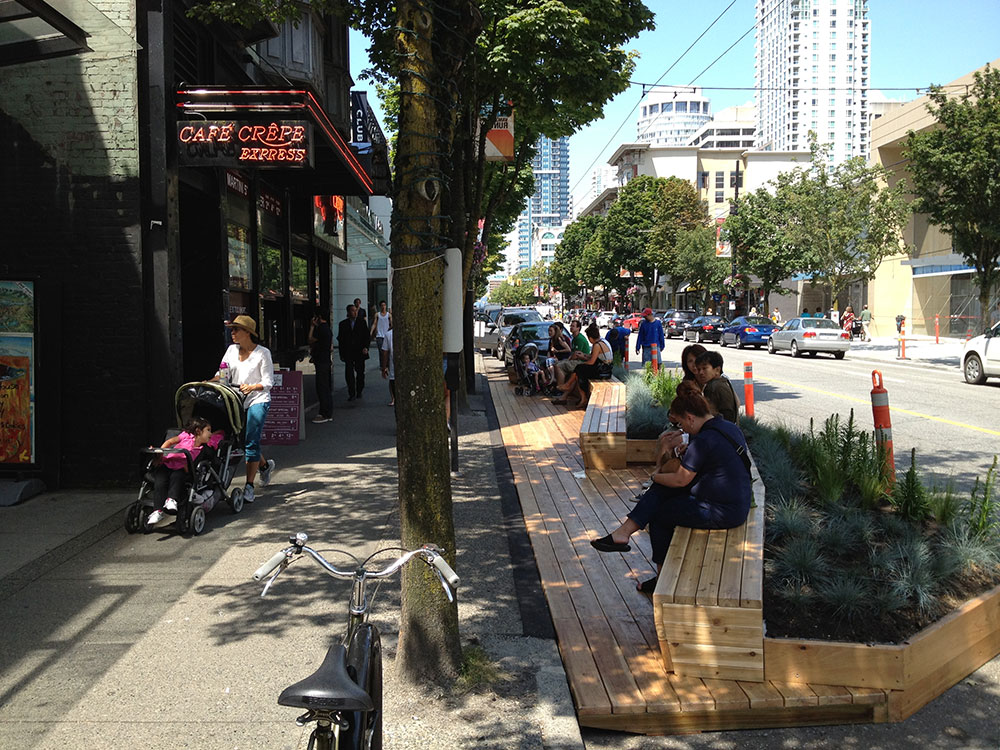
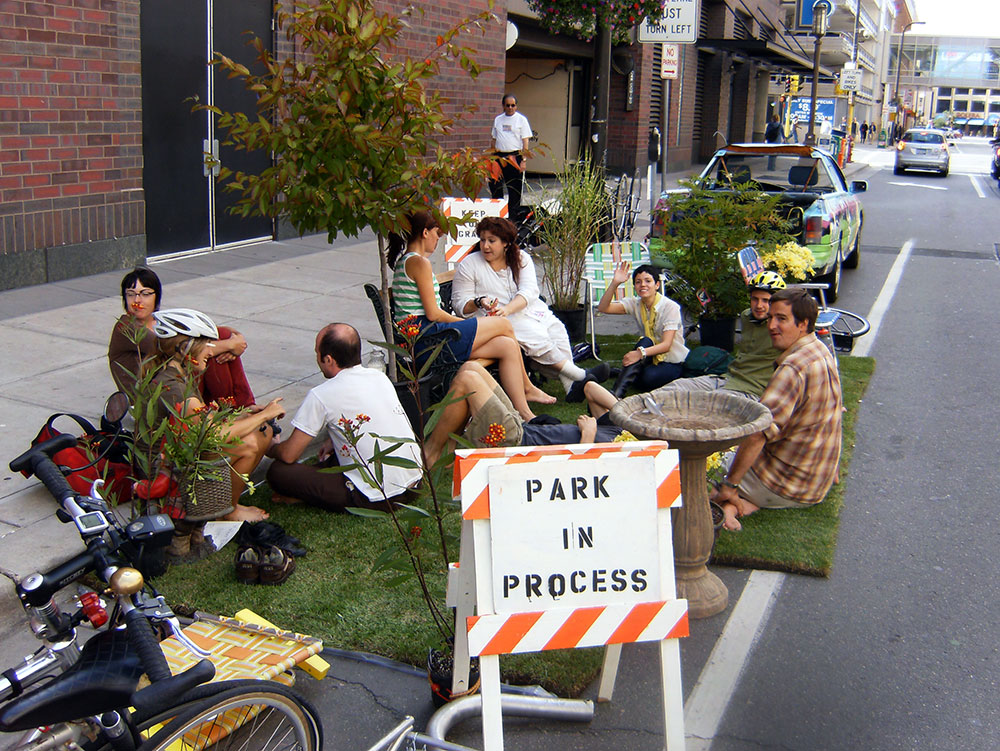
Park(ing) Day make-shift outdoor seating with temporary landscaping in the streets.
Scale and feasibility
Biophilic design patterns should be scaled to the surrounding environment and to the predicted user population for the space. Patterns can be applied at the scale of a micro-space, a room, a building, a neighborhood or campus, and even an entire district or city. Each of these spaces will present different design challenges depending on the programming, user types and dynamics, climate, culture, and various physical parameters, as well as existing or needed infrastructure.
Size and availability of space are two of the most common factors influencing feasibility of biophilic design patterns. For instance, the Prospect pattern [P11] typically requires significant space. Other patterns, such as Connection with Natural Systems [P7], may be more feasible where there is access to an outdoor space, which is a common challenge in dense urban environments. Yet small scale, micro-restorative Visual [P1] and Non-Visual Connections with Nature [P2] and Presence of Water [P5] can also be very effective. For instance, the psychological benefits of nature actually have been shown to increase with exposure to higher levels of biodiversity (118. Fuller el al., 2007 ), yet these benefits do not necessarily increase with greater natural vegetative area. From this we can derive that small, micro-restorative experiences that are also biodiverse are likely to be particularly effective at engendering a restorative biophilic experience.
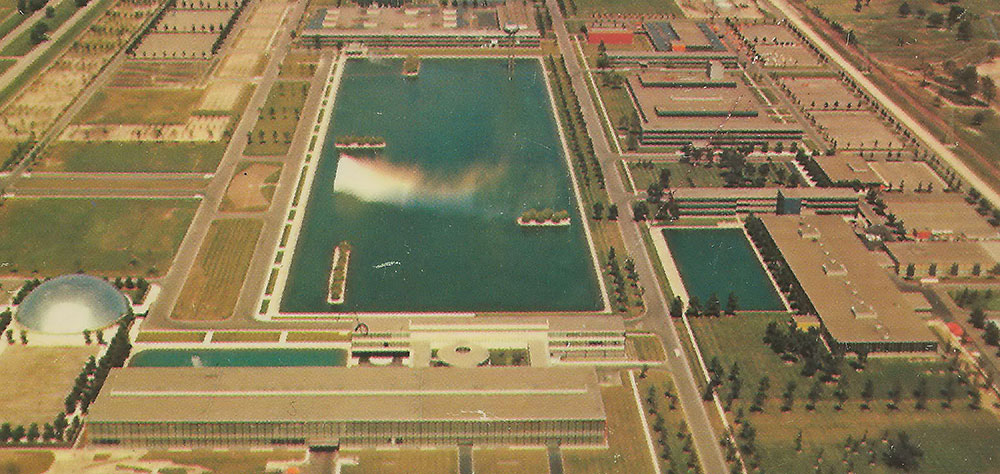
Micro-restorative experiences might include moments of sensory contact with nature through a window, television, image, painting or an aquarium. In urban environments where sensory overload is common (119. Joye, 2007 ), such experiences will be most valued and impactful when situated in locations with high foot traffic, allowing for a greater frequency of access to trigger the desired biophilic response. Traditional Japanese doorway gardens are a perfect example of replicable small-scale interventions.
The speed at which one moves through an environment, whether rural or urban, impacts the level of observable detail and the perceived scale of buildings and spaces. The General Motors "Tech Center" in Warren, Michigan, designed by architect Eero Saarinen in 1949, is designed to be experienced at 30 mph, so for the pedestrian, the scale seems oversized and the spacing of buildings is oddly far apart. This is why stores on along strip malls have large, simple façades and signage, whereas stores within pedestrian zones tends to have smaller and perhaps more intricate signage. Similarly, the landscaping along freeway and highway greenbelts is typically done in large swaths for instant interpretability. In contrast, a pedestrian focused environment will have more fine-grained details in the landscape design to allow for pause, exploration, and a more intimate experience.
Some patterns, such as [P13] Mystery and [P14] Risk/Peril, might not be as feasible or cost-effective in an interior fit-out project because of the amount of space required to effectively implement the pattern. On the other hand, interior fit-outs are an excellent opportunity to introduce Natural Analogue patterns which can be applied to surfaces like walls, floors, and ceilings as well as furniture and window treatments. In addition, not all aspects of biophilia are space dependent. Some patterns (e.g., P2, P4, P6, P7) are more visceral or temporal, requiring little to no floor area, and other patterns (e.g., P8-P10) may simply guide design choices that were already a part of the design process.
Major renovations, new construction and master planning provide more opportunities for incorporating biophilic design patterns that are coupled with systems integration at the building, campus or community scale.
Culture and demographics
Biophobia & Ecophobia
Biophobia is a fear of or aversion to nature or living things ((Ulrich, 1993). Similarly, ecophobia refers to an unreasonable but deeply conditioned disgust for or reaction against natural forms or places.
While biophobia is arguably genetic, to a degree, both phobias are learnt response mechanisms through direct experience, culture and education which, according to Salingaros and Masden (2008), includes architectural education.
The most common biophobic responses are to spiders, snakes, predators, blood, and heights – elements that either directly threaten or signal danger through humanity's evolutionary path. When tempered with an element of safety (e.g., railing or glass window), however, the experience can be transformed into one of curiosity, exhilaration and even a type of mind-body systems recalibration.
Current evolutionary hypotheses and theories state that contemporary landscape preferences are influenced by human evolution, reflecting the innate landscape qualities that enhanced survival for humanity through time. These schools of thought include the biophilia hypothesis (120. Wilson, 1993 and 121. 1984 ), the savanna hypothesis (122. Orians & Heerwagen, 1992 ), the habitat theory and prospect-refuge theory (123. Appleton, 1977 ), and the preference matrix (124. R. Kaplan & Kaplan, 1989 ). While empirical research has shown that there is a degree of universality to landscape preferences among humans, preferences have been modified by cultural influences, experiences and socio-economic factors (125. Tveit et al, 2007 ). Variations in landscape preferences have thus emerged among immigrants, ethnic groups, subcultures, genders, and age groups.
Cultural constructs, social inertia and ecological literacy suffuse differing perspectives on what constitutes natural, nature, wild, or beautiful (126. Tveit et al, 2007 ; 127. Zube & Pitt, 1981 ). Environmental Generational Amnesia and the Ecological Aesthetic Theory help explain how some perspectives may have evolved, and these differences come to bear across countries and regions, as well as among neighborhoods within the same city.
And while ethnicity can play a role in influencing an individual's landscape preferences, cultures and groups across the world utilize landscapes and space in different ways (128. Forsyth & Musacchio, 2005 ). Frequency of use, nature of use, participation rates and purpose of visit all vary drastically between nationalities, cultures and sub-groups. These factors do not mean that certain ethnic groups have a lower appreciation for landscape or a less significant connection with nature. These groups simply utilize and interact with nature in ways that are compatible with their culture and needs. Identifying early on what those needs may be will help define parameters for appropriate design strategies and interventions.
Environmental Generational Amnesia
One of the cultural challenges to upholding that human-nature bond, as well as environmental stewardship, is a phenomenon known as Environmental Generational Amnesia, the shifting baseline for what is considered a normal environmental condition as it continues to degrade. As environmental degradation continues, the baseline continues to shift with each ensuing generation, each perceiving this degraded condition as the norm or non-degraded condition.
This shifting baseline varies across cultures, geographic regions and sub-groups (129. Kahn, 2009 ), influencing environmental stewardship, proximity and access to nature and the biophilic experience. Helping a community to understand what their home looked like when it was a healthy, intact ecosystem is one way of making a Connection with Natural Systems and will hopefully help foster and frame the importance of other areas of environmental quality.
Age and gender are also known to influence biophilic response trends. Women report higher perceived levels of stress than men, yet are less likely than their male counterparts to use available natural outdoor vegetative space during the work day (130. Lottrup, Grahn & Stigsdotter, 2013 ). Of particular interest is that the degree of enhanced immune function due to immersion in nature has been observed to differ between the genders. For instance, following a forest walk, immune function was increased for a period of 30 days in men, but only seven days in women (131. Li, 2010 ), suggesting that interventions targeting female populations in the workplace may need to either prioritize indoor nature experiences or improve accessibility for prolonged outdoor nature experiences.
Youth benefit the most from nature contact in terms of increasing self-esteem. The gains for self-esteem from nature contact are suggested to decline with age; elderly and youth benefit the least in terms of mood enhancement from nature contact (132. Barton & Pretty, 2010 ), yet both groups are equal in perceived restorativeness of natural over urban environments (133. Berto, 2007 ). With age also comes a differing preference in landscape in regards to perceived safety. While an urban woodland may be an enticing place for adventure for a child or teenager, the same condition could be perceived by adults and elderly populations as risky (134. Kopec, 2006 ), which could possibly be overcome by incorporating a Prospect-Refuge condition.
3.4 Design Integration
Interdisciplinary planning and design
Developing an interdisciplinary strategy early on in a project will help ensure cost-effective opportunities are not lost before they are fully considered. Biophilia is but one piece of the puzzle to creating a vibrant, sustainable, and restorative environment. The integration of a multi-disciplinary strategy in the early stages of development – through a stakeholder charrette process or similar – will put team members on equal footing and allow for the identification of potential strengths, challenges and opportunities. In the long run, this approach will improve project satisfaction and save money.
Biophilia as an environmental quality
Environmental quality is an umbrella term that refers to the sum of the properties and characteristics of a specific environment and how it affects human beings and other organisms within its zone of influence.
Biophilia, like air quality, thermal comfort and acoustics, is an essential component of environmental quality that expands the conversation from daylight, materials toxicity, and air, water and soil quality, to include human biological health and well-being.
When integral to the environmental quality discussion, biophilia may also help dissolve the perceived division between human needs and building performance. And we would be remiss not to acknowledge that back-of-house and night shift workers are often the most deprived of biophilic experiences, while they are also the very people responsible for monitoring and maintaining building performance standards. From an architectural perspective, biophilic design patterns have the potential to refocus the designer's attention on the links between people, health, high-performance design and aesthetics.
Multi-platform solutions
Thoughtful applications of biophilic design can create a multi-platform strategy for familiar challenges traditionally associated with building performance such as thermal comfort, acoustics, energy and water management, as well as larger scale issues such as asthma, biodiversity and flood mitigation. We know increased natural air flow can help prevent sick building syndrome; daylighting can cut energy costs in terms of heating and cooling (135. Loftness & Snyder, 2008 ); and increased vegetation can reduce particulate matter in the air, reduce urban heat island effect, improve air infiltration rates and reduce perceived levels of noise pollution (136. Forsyth & Musacchio, 2005 ). These strategies can all be implemented in a manner that achieves a biophilic response for improved performance, health and well-being.
Biophilic design interventions that integrate with other building performance strategies have the potential to improve user experience and overall systems efficiency. Herbert Dreiseitl's design for Prisma in Nürnberg, Germany, is a good example; sculptural water walls serve as both a thermal control device and exposed rainwater conduit, while contributing to the visual and acoustic ambiance of the enclosed garden-like atrium. For the design of the Khoo Teck Puat Hospital in Singapore, architect RMJM met with ecologists and engineers early in the project development process to employ biophilia, ecological conservation and water sensitive urban design to manage rainwater, mitigate loss of biodiversity and create a restorative environment for patients, reaping more benefits for the project than any one of the three teams could have on their own (137. Alexandra Health, 2013 ). The biophilic experiences are more likely to persist long term when they are embedded in the programming and infrastructure of a place.
Controlling for effectiveness
The Ecological Aesthetic Theory
The ecological aesthetic theory proclaims that knowledge about the ecological functions of a landscape will increase preference ratings for that landscape. This theory depends on knowledge as a key driver of landscape preference (138. Nassauer, 1995 ).
As a cultural theory, it can somewhat explain the variations in landscape preferences between social classes. For instance, college students are reported to have more favorable attitudes towards wilderness than secondary school students (139. Balling & Falk, 1982 ).
Preferences for more tamed landscapes, typical of heavily urbanized environments, by lower income groups, is contrasted by the preference for wilder landscapes by higher income groups; it can be deduced that education, more accessible to those with higher socioeconomic status, plays a key role in developing the ecological aesthetic (140. Forsyth & Musacchio, 2005 ).
Given that landscapes and people's needs are in a constant state of flux, it is challenging to ensure the desired health response is always experienced. It is impossible to predict all future human-nature interactions or to ensure that the desired response recurs over a period of time for every user based on a particular strategy or intervention. Indeed, we can assume that efficacy of many biophilic patterns are likely to rise and decline with diurnal and seasonal cycles. For instance, the health benefits of a view to nature may be diminished during winter months or completely negated for night shift workers when the view is shrouded in darkness. However, secondary or seasonal strategies can help maintain balance, such as with indoor interventions, delivering the desired response throughout the year.
User controls for lighting, heating, cooling, ventilation, and even noise can either complement design efforts, or negate them when controls are mismanaged or underutilized – keeping the window blinds closed eliminates a Visual Connection with Nature, and high partitions in an open plan office eliminates opportunities for Prospect and a number of other patterns (141. Urban Green Council, 2013 ).
Behavior change is not often in the purview of the architect, so designing for controllability versus automation or permanency may inform the intervention design process. Maintenance of implemented strategies is also a consideration – will there be someone responsible for cleaning the fish tank and watering the plants? Having trainings and discussions with facility operators and a reference guide indicating appropriate maintenance requirements and parameters will help uphold the intended biophilic experience set forth in the design strategy.
Tracking and measuring efficacy
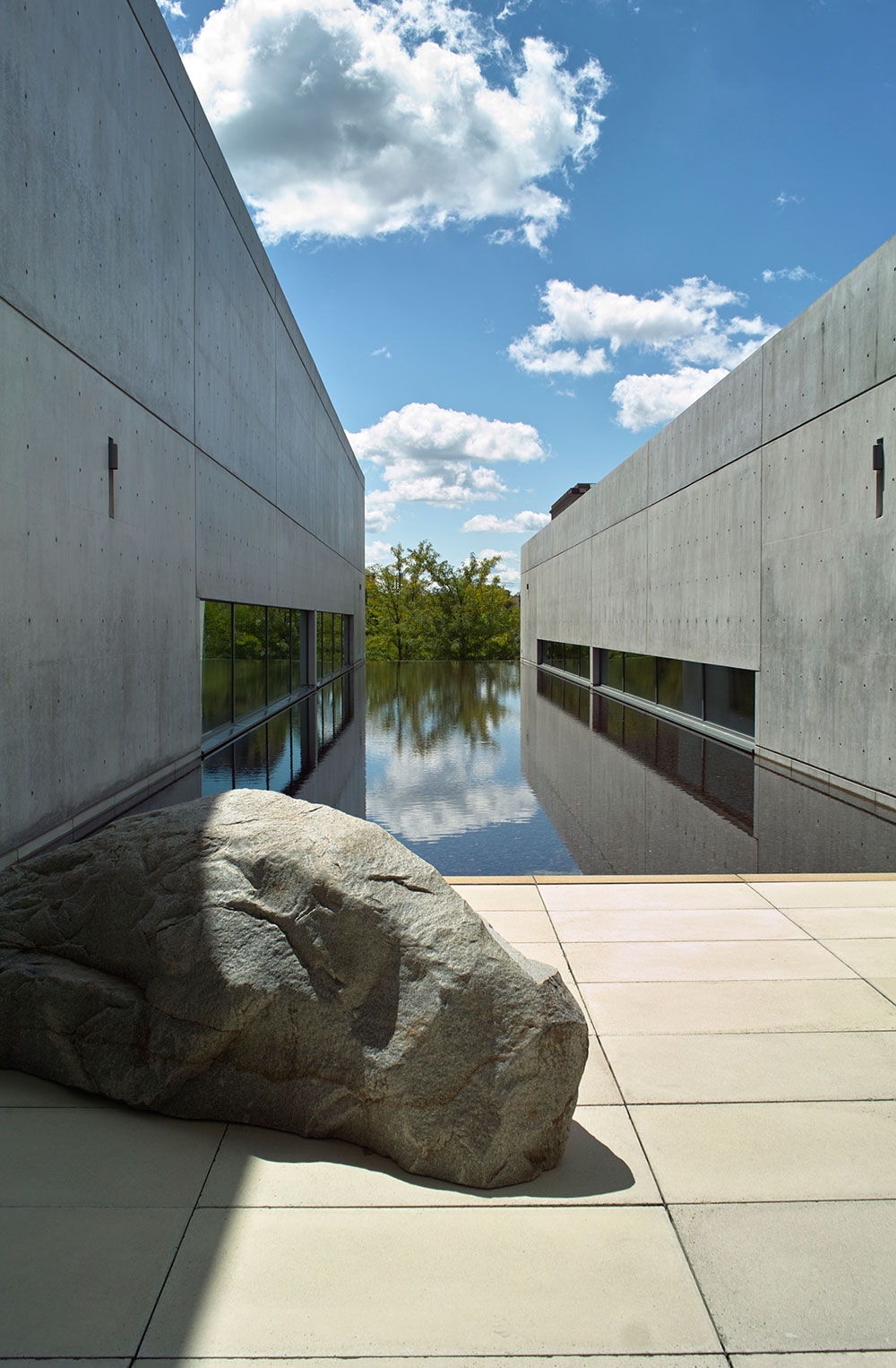
Reflecting pool at the Pulitzer Foundation for the Arts by Tadao Ando, St. Louis.
Monitoring efficacy of implemented biophilic design patterns for the express purpose of improving health and well-being is a new branch of inquiry. Variability in the built environment, as discussed here, creates a challenging framework for verification; quantitative metrics are often desired but not always appropriate, and the highly invasive nature of some measurement techniques and tools (i.e., fMRI, EEG) adds a layer of complexity and cost. Many of the current techniques used require strict control of variables and cost which tends to limit the size of the test group. There are, however, several new technologies, like wristband monitors, and very light weight headband EEG that may open up new rapid methods of testing; but until those technologies go mainstream, rapid testing can also be done in more rudimentary fashion and with a smaller budget.
As no two interventions will be exactly the same, all results will differ to one degree or another. Culture, climate, age, gender, landscape character, immigrant status, mental health, and genetic predispositions, for example, create a challenging labyrinth of data for comparison. Nevertheless, tracking and monitoring of human biological responses and outcomes triggered by a biophilic pattern is vital in the progress and further development of biophilic design as a best practice.
The science of biophilia is a rapidly evolving field. There is an increasing interest in biophilia research in psychology, neuroscience and endocrinology and our understanding of these patterns will be refined and strengthened as new evidence is gathered. It is entirely possible that additional patterns will emerge over time.
4. The Patterns
link to this section
"…Biophilia is not a single instinct but a complex of learning rules that can be teased apart and analyzed individually. The feelings molded by the learning rules fall along several emotional spectra: from attraction to aversion, from awe to indifference, from peacefulness to fear-driven anxiety."
Pattern as Precedent
In the two decades since Wilson published The Biophilia Hypothesis, the body of evidence supporting biophilia has expanded considerably. The biophilic design patterns in this paper have, in the words of Wilson, been "teased apart and analyzed individually" to reveal emotional affiliations Wilson spoke of, as well as other psychophysiological and cognitive relationships with the built environment. The descriptive term 'pattern' is being used for three reasons:
- to propose a clear and standardized terminology for biophilic design;
- to avoid confusion with multiple terms (metric, attribute, condition, characteristic, typology, etc.) that have been used to explain biophilia and biophilic design; and
- to maximize accessibility across disciplines by upholding a familiar language.
The use of spatial patterns is inspired by the precedents of A Pattern Language (142. Alexander, Ishikawa, Silverstein et al., 1977 ), Designing with People in Mind (143. R. Kaplan, S. Kaplan, & Ryan, 1998 ) and Patterns of Home (144. Jacobson, Silverstein & Winslow, 2002 ), as well as lectures and compilations on form, language and complexity (145. Nikos Salingaros, 2000 ; 146. 2013 ). Christopher Alexander brings clarity to this intent with his explanation that patterns
"........describe a problem which occurs over and over again in our environment, and then describes the core of the solution to that problem, in such a way that you can use this solution a million times over, without ever doing it the same way twice."
Alexander's work built on the tradition of pattern books used by designers and builders from the eighteenth century onward, but his work focused on the psychological benefits of patterns and included descriptions of the three dimensional spatial experience, rather than the aesthetic focus of previous pattern books. These fourteen Patterns of Biophilic Design focus on psychological, physiological and cognitive benefits.
Working with Biophilic Patterns
While informed by science, biophilic design patterns are not formulas; they are meant to inform, guide and assist in the design process and should be thought of as another tool in the designer's toolkit. The purpose of defining these patterns is to articulate connections between aspects of the built and natural environments and how people react to and benefit from them.
After each pattern is defined, it is then discussed in terms of the following:
- The Experience briefly considers how the pattern might impact the way a space feels;
- Roots of the Pattern highlights key scientific evidence that relates human biology to nature and the built environment;
- Working with the Pattern highlights design attributes, examples, and considerations; and
- Relation to Other Patterns briefly notes opportunities for integrative biophilic design strategies.
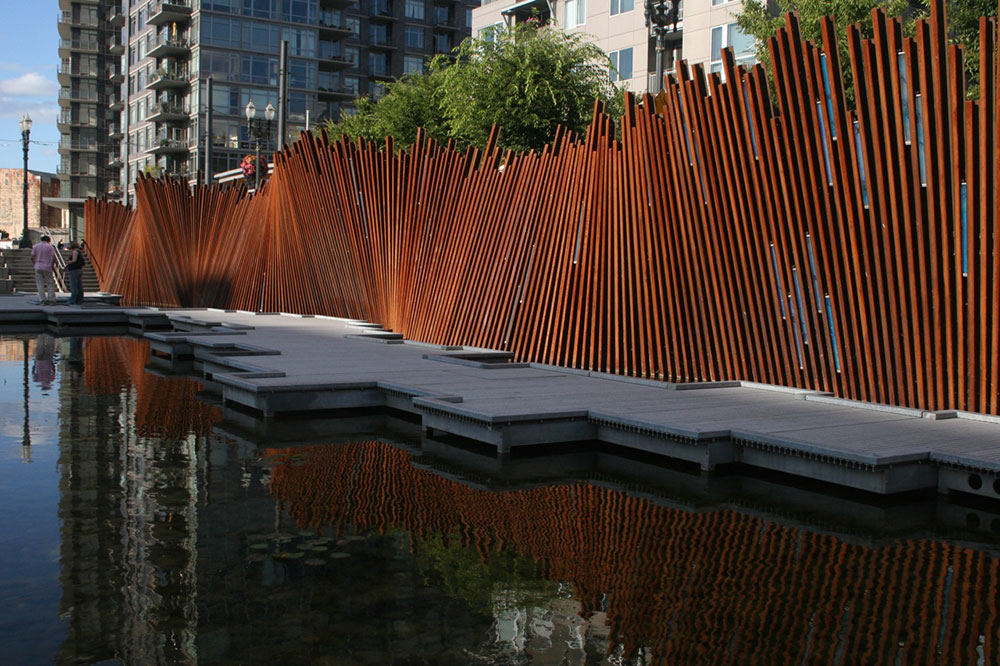
Just as combinations of culture, demographics, health baselines, and characteristics of the built environment can impact the experience of space differently, so too can each design pattern. A suitable solution results from understanding local conditions and one space's relationship to another, and responding appropriately with a combination of design interventions to suit the unique needs of a space and its intended user group and programs.
Finally, each pattern has been assessed for overall potential impact and the strength of the research on which a pattern is built. Unless otherwise noted, all examples reported are based on data published in a peer-reviewed journal. We acknowledge that some studies are more rigorous than others and that some patterns have a greater body of research to support findings of significance. To help communicate this variability, up to three asterisks are following each pattern name, whereby three asterisks (***) indicates that the quantity and quality of available peer-reviewed evidence is robust and the potential for impact is great, and no asterisk indicates that there is minimal research to support the biological relationship between health and design, but the anecdotal information is adequate for hypothesizing its potential impact and importance as a unique pattern.
The field of biophilic design is constantly evolving, and as Salingaros (2000) explains, new disciplines such as biophilic design must "abstract its patterns as they appear… building its own foundation and logical skeleton, upon which future growth can be supported." As new evidence comes to bear, it is entirely possible that some patterns will be championed over others and that new patterns will emerge. By establishing these 14 basic patterns, we hope to encourage the widespread scientific study, language development, and design implementation of Biophilia.
14 Patterns of Biophilic Design Improving Health and Well-Being in the Built Environment
Nature in the Space 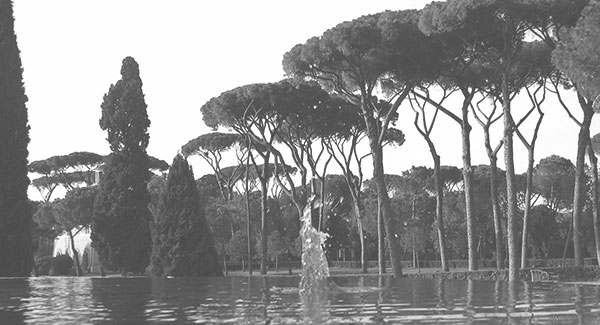
- Visual Connection with Nature A view to elements of nature, living systems and natural processes.
- Non-Visual Connection with Nature Auditory, haptic, olfactory, or gustatory stimuli that engender a deliberate and positive reference to nature, living systems or natural processes.
- Non-Rhythmic Sensory Stimuli Stochastic and ephemeral connections with nature that may be analyzed statistically but may not be predicted precisely.
- Thermal & Airflow Variability Subtle changes in air temperature, relative humidity, airflow across the skin, and surface temperatures that mimic natural environments.
- Presence of Water A condition that enhances the experience of a place through the seeing, hearing or touching of water.
- Dynamic & Diffuse Light Leveraging varying intensities of light and shadow that change over time to create conditions that occur in nature.
- Connection with Natural Systems Awareness of natural processes, especially seasonal and temporal changes characteristic of a healthy ecosystem.
Natural Analogues 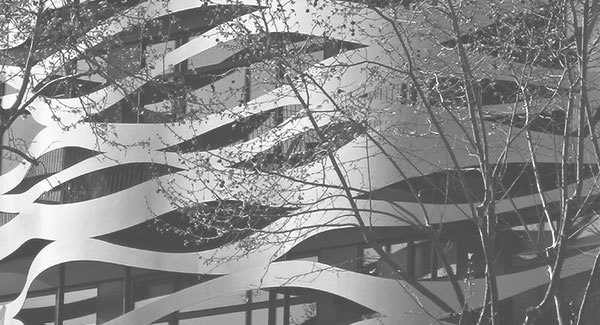
- Biomorphic Forms & Patterns Symbolic references to contoured, patterned, textured or numerical arrangements that persist in nature.
- Material Connection with Nature Material and elements from nature that, through minimal processing, reflect the local ecology or geology to create a distinct sense of place.
- Complexity & Order Rich sensory information that adheres to a spatial hierarchy similar to those encountered in nature.
Nature of the Space 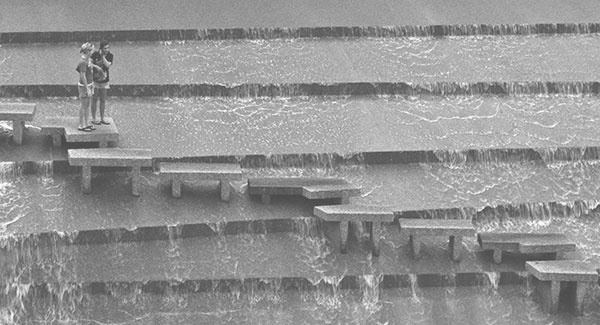
- Prospect An unimpeded view over a distance for surveillance and planning.
- Refuge A place for withdrawal, from environmental conditions or the main flow of activity, in which the individual is protected from behind and overhead.
- Mystery The promise of more information achieved through partially obscured views or other sensory devices that entice the individual to travel deeper into the environment.
- Risk/Peril An identifiable threat coupled with a reliable safeguard.
4.1 Nature in the Space
link to this sectionThe Experience
A space with a good Visual Connection with Nature feels whole, it grabs one's attention and can be stimulating or calming. It can convey a sense of time, weather and other living things.
Roots of the Pattern
Examples
Naturally Occurring:
- Natural flow of a body of water
- Vegetation, including food bearing plants
- Animals, insects
- Fossils
- Terrain, soil, earth
Simulated or Constructed:
- Mechanical flow of a body of water
- Koi pond, aquarium
- Green wall
- Artwork depicting nature scenes
- Video depicting nature scenes
- Highly designed landscapes
The Visual Connection with Nature pattern has evolved from research on visual preference and responses to views to nature showing reduced stress, more positive emotional functioning, and improved concentration and recovery rates. Stress recovery from visual connections with nature have reportedly been realized through lowered blood pressure and heart rate; reduced attentional fatigue, sadness, anger, and aggression; improved mental engagement/attentiveness, attitude and overall happiness. There is also evidence for stress reduction related to both experiencing real nature and seeing images of nature. Visual access to biodiversity is reportedly more beneficial to our psychological health than access to land area (i.e., quantity of land). [P1 Endnote ]
Visual preference research indicates that the preferred view is looking down a slope to a scene that includes copses of shade trees, flowering plants, calm non-threatening animals, indications of human habitation, and bodies of clean water (Orians & Heerwagen, 1992). This is often difficult to achieve in the built environment, particularly in already dense urban settings, though the psychological benefits of nature are suggested to increase with higher levels of biodiversity and not with an increase in natural vegetative area (Fuller et al., 2007). Positive impact on mood and self-esteem has also been shown to occur most significantly in the first five minutes of experiencing nature, such as through exercise within a green space (Barton & Pretty, 2010). Viewing nature for ten minutes prior to experiencing a mental stressor has shown to stimulate heart rate variability and parasympathetic activity (i.e., regulation of internal organs and glands that support digestion and other activities that occur when the body is at rest) (Brown, Barton & Gladwell, 2013), while viewing a forest scene for 20 minutes after a mental stressor has shown to return cerebral blood flow and brain activity to a relaxed state (Tsunetsugu & Miyazaki, 2005).
Parallax
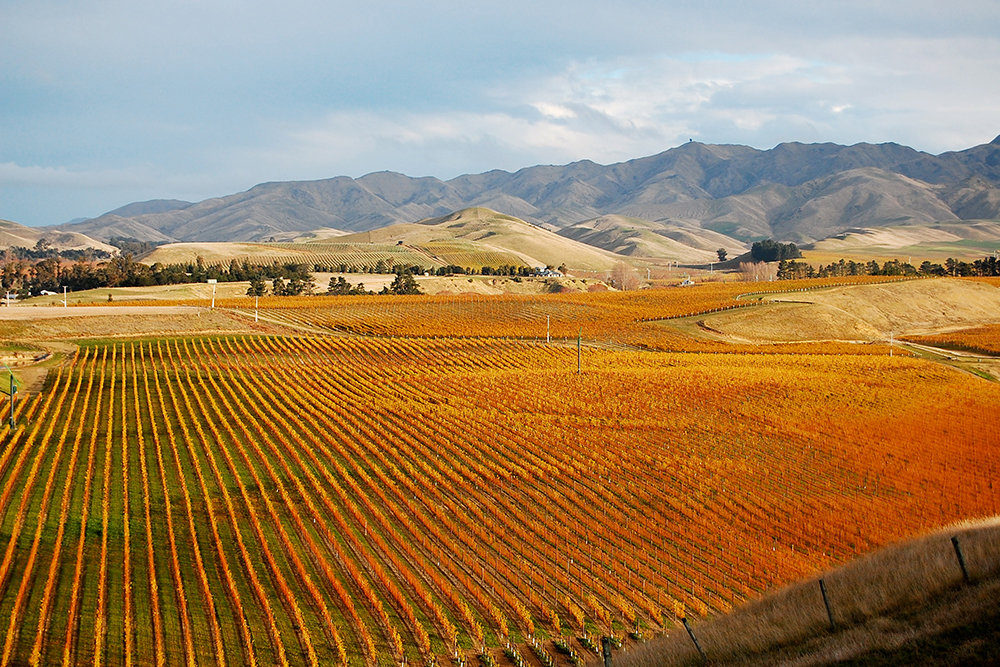
Parallax arises with a change in viewpoint occurring due to motion of the observer, of the observed, or of both. The human brain exploits the parallax to gain depth perception and estimate distances to objects.
Viewing scenes of nature stimulates a larger portion of the visual cortex than non-nature scenes, which triggers more pleasure receptors in our brain, leading to prolonged interest and faster stress recovery. For example, heart rate recovery from low-level stress, such as from working in an office environment, has shown to occur 1.6 times faster when the space has a glass window with a nature view, rather than a high-quality simulation (i.e., plasma video) of the same nature view, or no view at all (Kahn et al., 2008). Additionally, repeated viewing of real nature, unlike non-nature, does not significantly diminish the viewer's level of interest over time (Biederman & Vessel, 2006).
Working with the Pattern
The objective of the Visual Connection with Nature pattern is to provide an environment that helps the individual shift focus to relax the eye muscles and temper cognitive fatigue. The effect of an intervention will improve as the quality of a view and the amount of visible biodiversity each increases.
A view to nature through a glass window provides a benefit over a digital screen (e.g., video/plasma tv) of the same view, particularly because there is no parallax shift for people as they move toward or around a video screen (Kahn et al., 2008). This may change as three-dimensional videography advances. Nevertheless, simulated or constructed nature is measurably better at engendering stress reduction than having no visual connection at all.
Design considerations for establishing a strong visual connection with nature:
Relation to other Patterns
Visual Connection with Nature is often paired with a number of other patterns. Common overlaps with the most significant potential impact:
- [P2] Non-Visual Connection with Nature
- [P3] Non-Rhythmic Sensory Stimuli
- [P5] Presence of Water
- [P8] Biomorphic Forms & Patterns
- [P11] Prospect
- Prioritize real nature over simulated nature; and simulated nature over no nature.
- Prioritize biodiversity over acreage, area or quantity.
- Prioritize or enable exercise opportunities that are in proximity to green space.
- Design to support a visual connection that can be experienced for at least 5-20 minutes per day.
- Design spatial layouts and furnishings to uphold desired view lines and avoid impeding the visual access when in a seated position.
- Visual connections to even small instances of nature can be restorative, and particularly relevant for temporary interventions, or spaces where real estate (floor/ground area, wall space) is limited.
- The benefits of viewing real nature may be attenuated by a digital medium, which may be of greatest value to spaces that, due to the nature of its function (e.g., hospital radiation units), cannot easily incorporate real nature or views to the outdoors.
An example of a designed environment with an excellent Visual Connection with Nature is the birch tree and moss garden in the New York Times Building in New York City – a carved out space in the middle of the building by which everyone passes as they enter or leave the building. Adjacent to a restaurant and the main conference rooms, the birch garden is an oasis of calm in the hustle and bustle of Times Square.
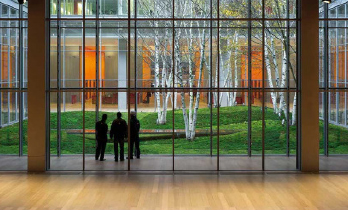

The Experience
A space with a good Non-Visual Connection with Nature feels fresh and well balanced; the ambient conditions are perceived as complex and variable but at the same time familiar and comfortable, whereby sounds, aromas, and textures are reminiscent of being outdoors in nature.
Roots of the Pattern
The Non-Visual Connection with Nature pattern has evolved from research on reductions in systolic blood pressure and stress hormones; impact of sound and vibration on cognitive performance; and perceived improvements in mental health and tranquility as a result of non-visual sensory interactions with non-threatening nature [P2 Endnote ]. Each sensory system has a vast body of research to support it; here we provide just a taste.
Examples
Naturally Occurring:
- Fragrant herbs and flowers
- Songbirds
- Flowing water
- Weather (rain, wind, hail)
- Natural ventilation (operable windows, breezeways)
- Textured materials (stone, wood, fur)
- Crackling fire/fireplace
- Sun patches
- Warm/cool surfaces
Simulated or Constructed:
- Digital simulations of nature sounds
- Mechanically released natural plant oils
- Highly textured fabrics/textiles that mimic natural material textures
- Audible and/or physically accessible water feature
- Music with fractal qualities
- Horticulture/gardening, including edible plants
- Domesticated animals/pets
- Honeybee apiary
Auditory: Research shows that exposure to nature sounds, when compared to urban or office noise, accelerates physiological and psychological restoration up to 37% faster after a psychological stressor (Alvarsson et al., 2010) and reduces cognitive fatigue and helps motivation (Jahncke et al., 2011). Participants of one study who either listened to river sounds or saw a nature movie with river sounds during a post-task restoration period reported having more energy and greater motivation after the restoration period compared to participants who only listened to office noise or silence (Jahncke et al., 2011). In addition, viewing the nature movie with river sounds during the restoration period had a more positive affect than only listening to river sounds alone.
Ocean waves and vehicle traffic can have a very similar sound pattern. In an experiment using a synthesized sound that replicated the waves and traffic sound pattern, researchers observed that participants processed the synthesized sound in different portions of the brain depending on whether they were also watching a video of either waves or vehicle traffic (Hunter et al., 2010). Participants considered the sound to be pleasurable when viewing the video of waves, but not when viewing the video of traffic. This study suggests a strong connection between our visual and auditory sensory systems and psychological well-being.
Olfactory: Our olfactory system processes scent directly in the brain, which can trigger very powerful memories. Traditional practices have long used plant oils to calm or energize people. Studies have also shown that olfactory exposure to herbs and phytoncides (essential oils from trees) have a positive effect on the healing process and human immune function, respectively (Li et al., 2012; Kim et al., 2007).
Haptic: Pet therapy, where companionship and the act of petting and feeling the fur of domesticated animals, is known to have profound calming effects on patients; gardening and horticulture activities have shown to engender environmental stewardship among children, reduce self-reported fatigue while maintaining joint flexibility among adults (e.g., Yamane et al., 2004), and reduce perception of pain among senior populations with arthritis. The act of touching real plant life, versus synthetic plants, has also shown to induce relaxation through a change in cerebral blood flow rates (e.g., Koga & Iwasaki, 2013). These examples give reason to believe that the experience of touching other elements in nature, such as water or raw materials, may result in similar health outcomes.
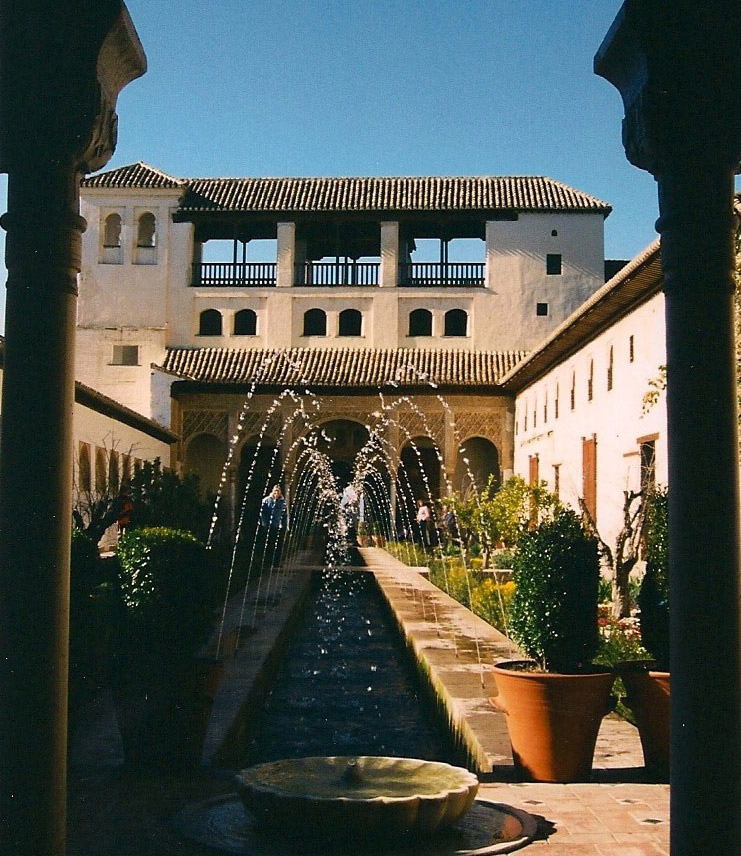
A fountain and gardens in the Calat Alhambra in Granada, Spain provide a non-visual experience of nature.
Gustatory: Tasting is yet another way of experiencing nature and learning about our environment. While adults are often curious or fearful of edible plants and herbs, consider the familiar habit of infants and toddlers putting found objects in their mouths – they are seeking information.
Working with the Pattern
The objective of the Non-Visual Connection with Nature pattern is to provide an environment that uses sound, scent, touch and possibly even taste to engage the individual in a manner that helps reduce stress and improve perceived physical and mental health. These senses can be experienced separately, although the experience is intensified and the health effect is compounded if multiple senses are consistently engaged together.
Design considerations for establishing a strong non-visual connection with nature:
- Prioritize nature sounds over urban sounds.
- Design for non-visual connections that can be easily accessed from one or multiple locations, and in such a way that allows daily engagement for 5 to 20 minutes at a time.
- Integrate non-visual connections with other aspects of the design program.
- A single intervention that can be experienced in multiple ways can enhance the impacts.
- Design for visual and non-visual connections to be experienced simultaneously to maximize potential positive health responses.
Relation to other Patterns
As experiences can be enhanced when paired with more than one sense, the application of a second pattern could help identify the stimuli or other qualities of the stimuli. Common strategy overlaps:
- [P1] Visual Connection with Nature
- [P3] Non-Rhythmic Sensory Stimuli
- [P4] Thermal & Airflow Variability
- [P9] Material Connection with Nature
- [P5] Presence of Water
-
and sometimes also:
[P13] Mystery
Calat Alhambra in Granada, Spain, is an exquisite example of the 14 Patterns. While some patterns are more evident in some spaces than others, Non-Visual Connections with Nature are experienced throughout. The integration of water and natural ventilation with the architecture is central to the non-visual experience, supporting a seamless connection between indoor and outdoor spaces, and between the building and the surrounding natural landscape. Solar heat penetrates at distinct locations, the whispering gallery resonates sounds of nature and people, and gardens of rosemary, myrtles, and other fragrant plants surround the premises. The extensive use of water fountains creates a microclimate – the space both sounds and feels cooler – while stone floors and handrails with water channels cool the feet and hands through conductance.

The Experience
A space with good Non-Rhythmic Sensory Stimuli feels as if one is momentarily privy to something special, something fresh, interesting, stimulating and energizing. It is a brief but welcome distraction.
Roots of the Pattern
Examples
Naturally Occurring:
- Cloud movement
- Breezes
- Plant life rustling
- Water babbling
- Insect and animal movement
- Birds chirping
- Fragrant flowers, trees and herbs
Simulated or Constructed:
- Billowy fabric or screen materials that move or glisten with light or breezes
- Reflections of water on a surface
- Shadows or dappled light that change with movement or time
- Nature sounds broadcasted at unpredictable intervals
- Mechanically released plant oils
The Non-Rhythmic Sensory Stimuli pattern has evolved from research on looking behavior (particularly periphery vision movement reflexes); eye lens focal relaxation patterns; heart rate, systolic blood pressure and sympathetic nervous system activity; and observed and quantified behavioral measures of attention and exploration.[P3 Endnote ]
Studies of the human response to stochastic movement of objects in nature and momentary exposure to natural sounds and scents have shown to support physiological restoration. For instance, when sitting and staring at a computer screen or doing any task with a short visual focus, the eye's lens becomes rounded with the contracting of the eye muscles. When these muscles stay contracted for an extended period, i.e., more than 20 minutes at a time, fatigue can occur, manifesting as eye strain, headaches and physical discomfort. A periodic, yet brief visual or auditory distraction that causes one to look up (for >20 seconds) and to a distance (of >20 feet) allows for short mental breaks during which the muscles relax and the lenses flatten (Lewis, 2012; Vessel, 2012).
Working with the Pattern
The objective of the Non-Rhythmic Sensory Stimuli pattern is to encourage the use of natural sensory stimuli that unobtrusively attract attention, allowing individuals' capacity for focused tasks to be replenished from mental fatigue and physiological stressors. This can be achieved by designing for momentary exposure to the stochastic or unpredictable movement, particularly for periphery vision or the periodic experience of scents or sounds.
Relation to other Patterns
Non-Rhythmic Sensory Stimuli differs from [P2] Non-Visual Connection with Nature in that it is inclusive of all sensory systems and is most commonly experienced at a subconscious level through momentary exposure that is not typically sought out or anticipated; whereas Non-Visual Connection may be deliberate, planned, and over longer, more predictable durations of time. Common strategy overlaps:
- [P1] Visual Connection with Nature
- [P4] Thermal & Airflow Variability
- [P5] Presence of Water
- [P10] Complexity & Order
- [P13] Mystery
When immersed in nature, we continually experience instances of non-rhythmic stimuli: birds chirping, leaves rustling, the faint scent of eucalyptus in the air. The built environment has evolved into a deliberately predictable realm. Even some highly manicured gardens and certainly interior vegetation lack the qualities needed to support non-rhythmic sensory stimuli.
Design considerations for establishing accessible and effective non-rhythmic stimuli:
- As a general guideline, non-rhythmic sensory experiences should occur approximately every 20 minutes for about 20 seconds and, for visual stimuli, from a distance of more than 20 feet away.
- Many stimuli in nature are seasonal, so a strategy that is effective year-round, such as with multiple interventions that overlap with seasons, will help ensure that non-rhythmic sensory experiences can occur at any given time of the year.
- In some cases, the intervention may be similar to that of [P1] Visual or [P2] Non-Visual Connection with Nature; what's important here is the ephemeral and stochastic quality of the intervention.
- An intervention that leverages simulation of (rather than naturally occurring) natural stimuli will likely necessitate early collaboration with the mechanical engineer or facilities team.
- A non-rhythmic stimuli strategy can be interwoven with almost any landscape or horticulture plan. For instance, selecting plant species for window boxes that will attract bees, butterflies and other pollinators may be a more practical application for some projects than maintaining a honeybee apiary or butterfly sanctuary.
- Humans perceive movement in the peripheral view much quicker than straight ahead. The brain also processes the movement of living things in a different place than it does of mechanical objects (Beauchamp et al., 2003), whereby natural movement is generally perceived as positive, and mechanical movement as neutral or even negative. As a result, the repeating rhythmic motion of a pendulum will only hold one's attention briefly, the constant repetitive ticking of a clock may come to be ignored over time, and an ever-present scent may lose its mystique with long-term exposure; whereas, the stochastic movement of a butterfly will capture one's attention each time for recurring physiological benefits.
The Dockside Green community on Vancouver Island, Victoria, BC Canada, is a great example of non-rhythmic stimuli. The implementation of habitat restoration and rainwater management has led to ephemeral experiences of swaying grasses, falling water and the buzz of passing insects and animals that are visible from walkways, porches, and windows around the community.
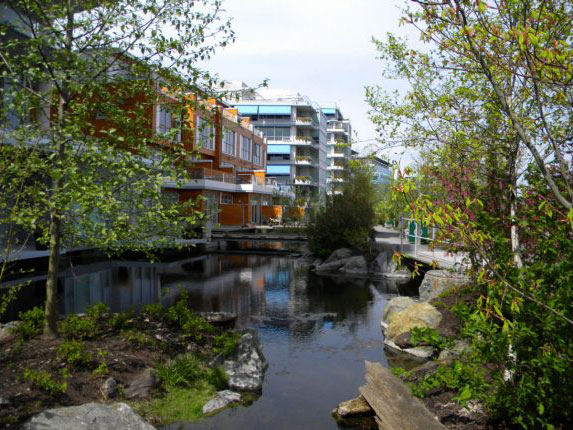

The Experience
A space with good Thermal & Airflow Variability feels refreshing, active, alive, invigorating and comfortable. The space provides a feeling of both flexibility and a sense of control.
Roots of the Pattern
The Thermal & Airflow Variability pattern has evolved from research measuring the effects of natural ventilation, its resulting thermal variability, and worker comfort, well-being and productivity; physiology and perception of temporal and spatial pleasure (alliesthesia); the impact of nature in motion on concentration; and, generally speaking, a growing discontent with the conventional approach to thermal design, which focuses on achieving a narrow target area of temperature, humidity and air flow while minimizing variability.[P4a Endnote ]
Research shows that people like moderate levels of sensory variability in the environment, including variation in light, sound and temperature, and that an environment devoid of sensory stimulation and variability can lead to boredom and passivity (e.g., Heerwagen, 2006) [P4b Endnote ]. Early studies in alliesthesia indicate that pleasant thermal sensations are better perceived when one's initial body state is warm or cold, not neutral (e.g., Mower, 1976), which corroborates more recent studies reporting that a temporary over-cooling of a small portion of the body when hot, or over-heating when cold, even without impacting the body's core temperature, is perceived as highly comfortable (Arens et al., 2006).
According to Attention Restoration Theory, elements of "soft fascination" such as light breezes or other natural movements can improve concentration (Heerwagen & Gregory, 2008; S. Kaplan, 1995). Other research indicates that a variety of thermal conditions within a classroom can lead to better student performance (Elzeyadi, 2012); and that changes in ventilation velocity can have a positive impact on comfort, with no negative impact on cognitive function, while also offering the possibility of some increase in the ability to access short term memory (Wigö, 2005).
Examples
Naturally Occurring:
- Solar heat gain
- Shadow and shade
- Radiant surface materials
- Space/place orientation
- Vegetation with seasonal densification
Simulated or Constructed:
- HVAC delivery strategy
- Systems controls
- Window glazing and window treatment
- Window operability and cross ventilation
Working with the Pattern
The objective of the Thermal & Airflow Variability pattern is to provide an environment that allows users to experience the sensory elements of airflow variability and thermal variability. The intent is also for the user to be able to control thermal conditions, either by using individual controls, or allowing occupants access to variable ambient conditions within a space.
In contrast, conventional thermal design tries to achieve a narrow target area of temperature, humidity and airflow, while minimizing variability – the goal being to maintain conditions within the "ASHRAE comfort envelope". When the entire space meets this goal, laboratory-based predictive models assert that 80% of the occupants would be satisfied at any given time – traditionally an acceptable outcome industry-wide. An alternative approach is to provide combinations of ambient and surface temperatures, humidity and airflow, similar to those experienced outdoors, while also providing some form of personal control (e.g., manual, digital, or physical relocation) over those conditions.
Providing variable conductance materials, seating options with differing levels of solar heat gain (indoors and outdoors) or proximity to operable windows – as welcome as catching a cooling breeze on a sunny day or leaning one's back on a warm rock on a cool day – could improve the overall satisfaction of a space.
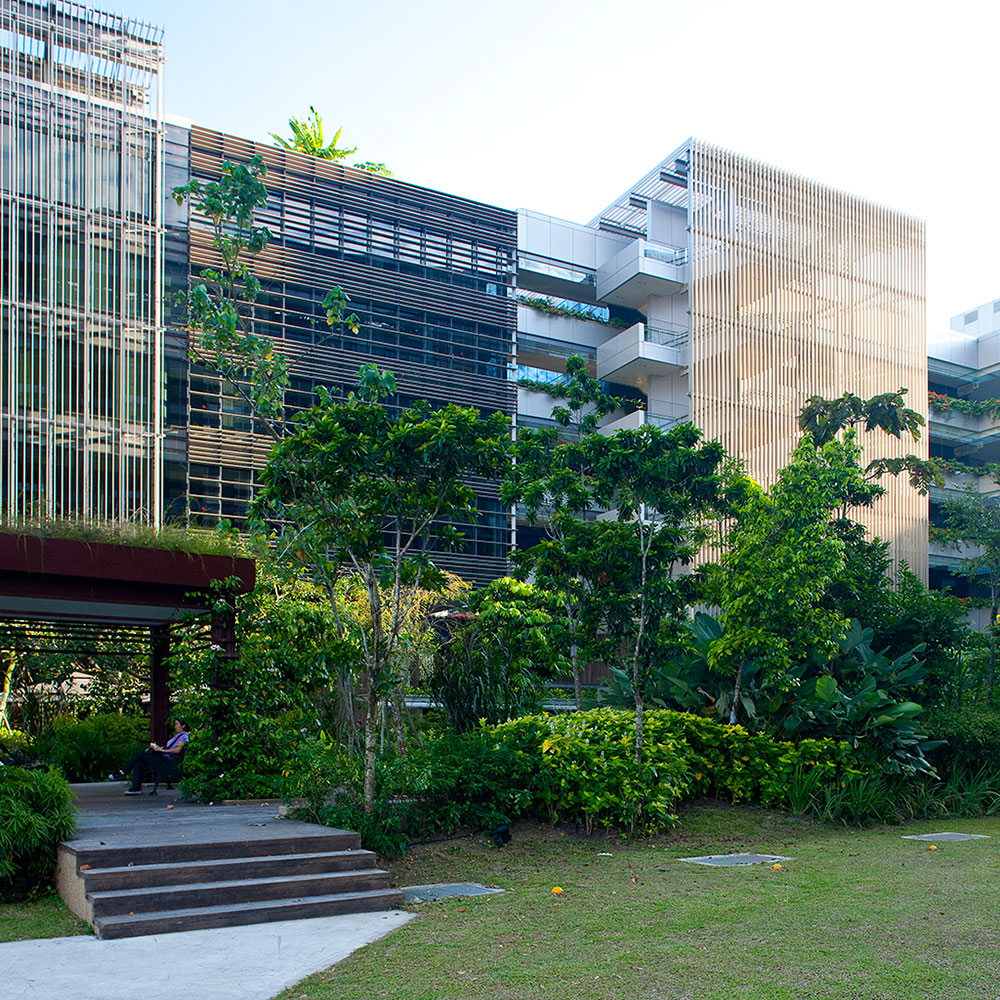
The Khoo Teck Puat Hospital in Singapore by RMJM Architects uses fresh air and sunlight to increase thermal comfort.
Since thermal comfort is inherently subjective, and strongly varies between people, it is important to give a degree of control to individuals, which can manifest architecturally (e.g., access to operable windows or shades) or mechanically (e.g., access to localized and energy-efficient fans or heaters, and thermostat controls). When an individual experiences thermal discomfort, he or she will likely take action to adapt (e.g., put on a sweater; move to a different seat; submit a complaint). Sometimes these adaptive actions are simply in response to dynamic changes in personal preference. In order to create an enhanced thermal experience, conditions do not have to reach the point of discomfort for these opportunities for changing the thermal conditions to create a positive experience (Brager, 2014).
Design considerations:
- Incorporation of airflow and thermal conditions into materials, daylighting, mechanical ventilation and/or fenestration will help distribute variability over space and time.
- Thermal comfort is a vital bridging component between biophilic design and sustainable design, especially in the face of climate change and rising energy costs. When Thermal & Airflow Variability is implemented in a way that broadens people's perception of thermal comfort, it may also help reduce energy demands for air conditioning and heating.
- Designing in features that allow users to easily adapt and modify their perceived thermal conditions of their environment will increase the range of acceptable temperatures by two degrees Celsius above and below the conventional parameters for thermal comfort (Nicol & Humphreys, 2002).
- Coordination of design strategies among a project team (e.g., architect, lighting designer and MEP engineers) as early as the schematic design process will be particularly important for achieving design intent.
Relation to other Patterns
Common overlaps:
- [P6] Dynamic & Diffuse Light
- [P7] Connection with Natural Systems
-
and sometimes also:
[P3] Non-Visual Connection with Nature - [P5] Presence of Water
- [P13] Mystery
Singapore's Khoo Teck Puat Hospital by RMJM Architects is an excellent example of Thermal & Airflow Variability. The passive design of the hospital draws fresh air in from the exterior courtyards; the cool air helps maintain thermal comfort, while patients also have operable windows in their rooms, allowing for greater personal control. The façade and internal layouts are designed to enhance daylight and light/shade variability while reducing glare. Connecting, elevated exterior walkways also provide access to breezes, shade and solar heat.

The Experience
Examples
Naturally Occurring:
- River, stream, ocean, pond, wetland
- Visual access to rainfall and flows
- Seasonal arroyos
Simulated or Constructed:
- Water wall
- Constructed water fall
- Aquarium
- Fountain
- Constructed stream
- Reflections of water (real or simulated) on another surface
- Imagery with water in the composition
A space with a good Presence of Water condition feels compelling and captivating. Fluidity, sound, lighting, proximity and accessibility each contribute to whether a space is stimulating, calming, or both.
Roots of the Pattern
The Presence of Water pattern has evolved from research on visual preference for and positive emotional responses to environments containing water elements; reduced stress, increased feelings of tranquility, and lower heart rate and blood pressure from exposure to water features; improved concentration and memory restoration induced by complex, naturally fluctuating visual stimuli; and enhanced perception and psychological and physiological responsiveness when multiple senses are stimulated simultaneously.[P5 Endnote ]
Visual preference research indicates that a preferred view contains bodies of clean (i.e., unpolluted) water (Heerwagen & Orians, 1993). Research has also shown that landscapes with water elicit a higher restorative response and generally have a greater preference among populations in comparison to landscapes without water. Supporting evidence has suggested that natural scenes without water and urban scenes with water elements follow with primarily equal benefits (Jahncke et al., 2011; Karmanov & Hamel, 2008; White et al., 2010).
Research on response to activities conducted in green spaces has shown that the presence of water prompts greater improvements in both self-esteem and mood than activities conducted in green environments without the presence of water (Barton & Pretty, 2010). Auditory access and perceived or potential tactile access to water also reportedly reduces stress (Alvarsson et al., 2010; Pheasant et al., 2010).
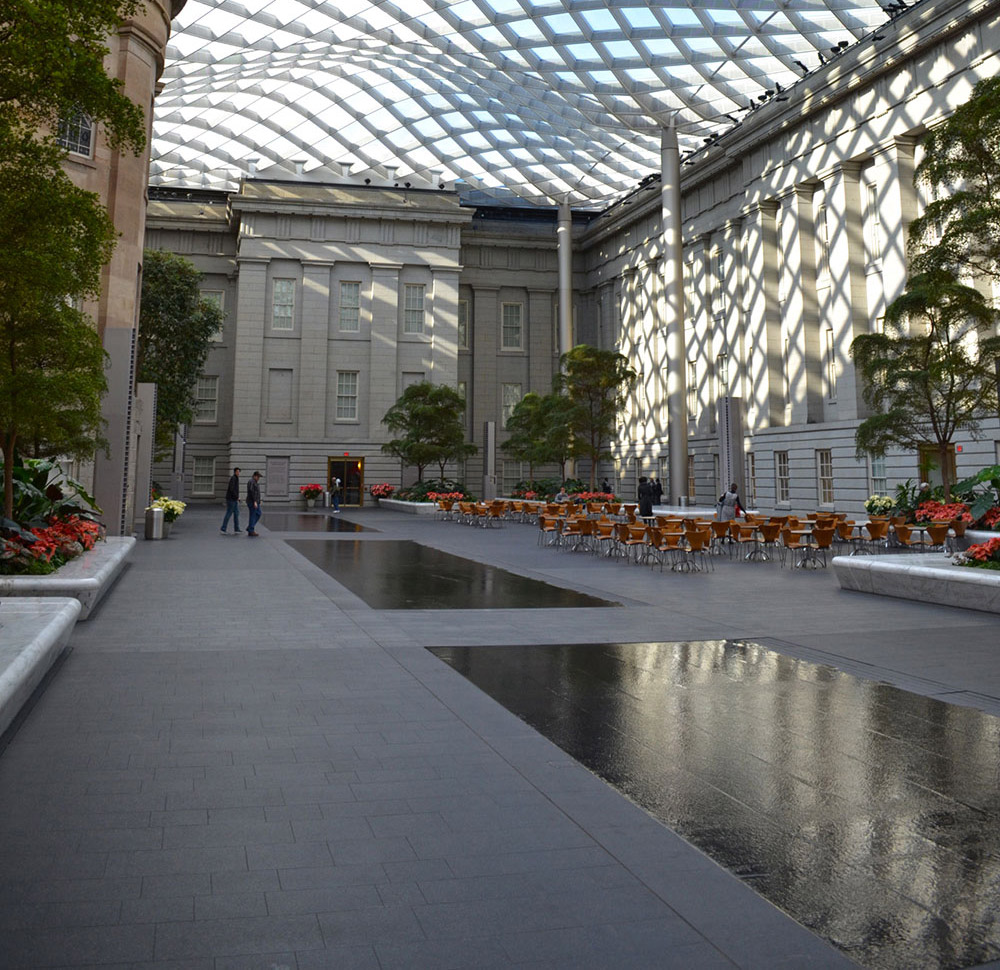
The Robert and Arlene Kogod Courtyard in the Smithsonian American Art Museum, Washington, D.C., by Foster + Partners and landscape designer Kathryn Gustafson of Seattle–based Gustafson Guthrie Nichol Ltd. has seamless water sheets running across the floor, reflecting weather and lighting conditions.
Working with the Pattern
The objective of the Presence of Water pattern is to capitalize on the multi-sensory attributes of water to enhance the experience of a place in a manner that is soothing, prompts contemplation, enhances mood, and provides restoration from cognitive fatigue.
Repeated experiences of water do not significantly diminish our level of interest over time (Biederman & Vessel, 2006), so one small water feature may be adequate. Taking advantage of the sounds created by small-scale running water, and our capacity to touch it, will amplify the desired health response with a multi-sensory experience. Vistas to large bodies of water or physical access to natural or designed water bodies can also have the health response so long as they are perceived as 'clean' or unpolluted. Images of nature that include aquatic elements are more likely to help reduce blood pressure and heart rate than similar imagery without aquatic elements.
Design considerations for optimizing the impacts of a presence of water:
- Prioritize a multi-sensory water experience to achieve the most beneficial outcome.
- Prioritize naturally fluctuating water movement over predictable movement or stagnancy.
- High volume, high turbulence water features could create discomfort, impact humidity levels or decrease acoustic quality, so proximity may influence appropriateness.
- Water features can be water and energy intensive and as such should be used sparingly, particularly in climates with little access to water. Shading the water, using high albedo surfaces, and minimizing the exposed water surface area will minimize water loss through evaporation, and possibly contribute to the biophilic experience.
Relation to other Patterns
Commonly enhanced patterns:
- [P1] Visual Connection with Nature
- [P2] Non-Visual Connection with Nature
- [P7] Connection with Natural Systems
- [P11] Prospect
- [P14] Risk/Peril
The Robert and Arlene Kogod Courtyard at the Smithsonian American Art Museum in Washington, D.C. is a great example of Presence of Water with its physically expansive water feature doubling as an event space. The former outdoor space has been enclosed with an undulating canopy design by Foster + Partners, bearing resemblance to water or clouds. On several portions of the gently sloping floors are slits from which a sheet of water emerges, it flows across the textured stone and then disappears into a series of slots toward the center of the courtyard. Designed by Gustafson Guthrie Nichol Ltd., the thin sheet of water reflects light and weather conditions from above and invites passersby to touch. During events the system is drained and seamlessly becomes part of the floor plane.

The Experience
A space with a good Dynamic & Diffuse Light condition conveys expressions of time and movement to evoke feelings of drama and intrigue, buffered with a sense of calm.
Roots of the Pattern
Examples
Naturally Occurring:
- Daylight from multiple angles
- Direct sunlight
- Diurnal and seasonal light
- Firelight
- Moonlight and star light
- Bioluminescence
Simulated or Constructed:
- Multiple low glare electric light sources
- Illuminance
- Light distribution
- Ambient diffuse lighting on walls and ceiling
- Day light preserving window treatments
- Task and personal lighting
- Accent lighting
- Personal user dimming controls
- Circadian color reference (white light during the day and lack of blue light at night)/
- Color tuning lighting that produces white light during the day, and minimizes blue light at night
Lighting design has long been used to set the mood for a space, and different lighting conditions elicit differing psychological responses. The impact of daylight on performance, mood and well-being has been studied for many years, in a variety of environments, and as a complex field of science and design, light has been extensively studied and written about.
Early research showed that productivity is higher in well daylighted work places, sales are higher in daylit stores, and that children performed better in daylighted classrooms with views – the research focus was on lighting strategy and task performance and less on human biology. For instance, quality daylighting has been reported to induce more positive moods and significantly less dental decay among students attending schools with quality daylight than students attending schools with average light conditions (Nicklas & Bailey, 1996).
Recent research has focused more heavily on illuminance fluctuation and visual comfort, human factors and perception of light, and impacts of lighting on the circadian system functioning.[P6 Endnote ] Sunlight changes color from yellow in the morning, to blue at midday, and red in the afternoon/evening; the human body responds to this daylight color transition. The response is apparent in body temperature, heart rate, and circadian functioning. Higher content of blue light (similar to skylight) produces serotonin; whereas, an absence of blue light (which occurs at night) produces melatonin. The balance of serotonin and melatonin can be linked to sleep quality, mood, alertness, depression, breast cancer and other health conditions (Kandel et al., 2013).
Working with the Pattern
The objective of the Dynamic & Diffuse Light pattern is twofold: to provide users with lighting options that stimulate the eye and hold attention in a manner that engenders a positive psychological or physiological response, and to help maintain circadian system functioning. The goal should not be to create uniform distribution of light through a (boring) space, nor should there be extreme differences (i.e., glare discomfort).
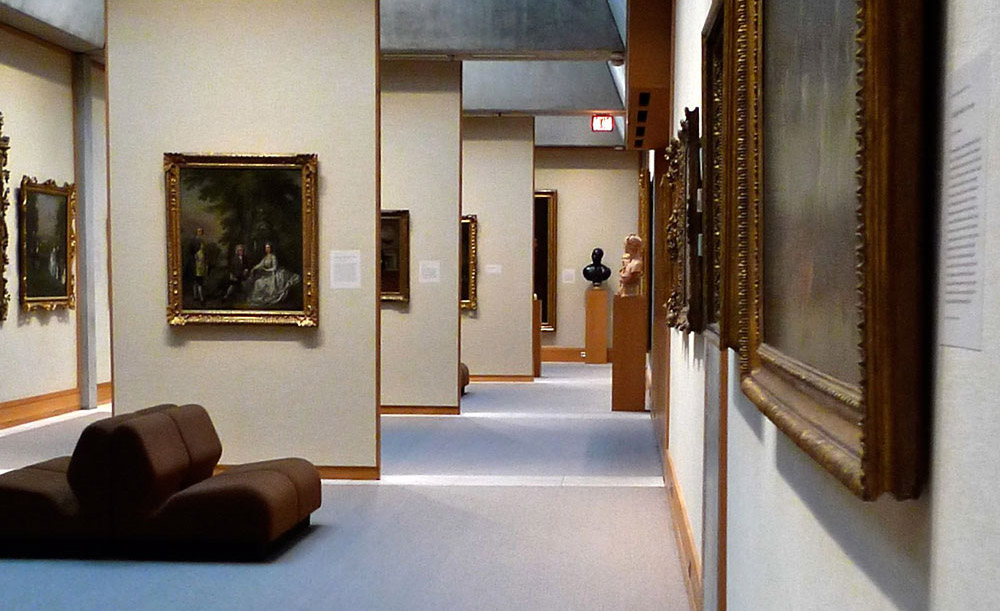
The Yale Center for British Art in New Haven, CT, by Louis Kahn utilizes natural lighting to sofly illuminate art and create dramatic experiences.
The human eye and the processing of light and images within the brain are adaptable over a broad range of conditions, although there are limitations. For example, when the lighting difference between adjoining sources or surfaces has a brightness or luminance ratio of greater than forty-to-one, glare may occur, which diminishes visual comfort (Clanton, 2014). For work areas, luminance ratios between task and immediate surroundings should not exceed 10 to one. So while dramatic lighting differences may be great for some religious, socialization and circulation spaces, they are not a good idea on work surfaces.
Diffuse lighting on vertical and ceiling surfaces provides a calm backdrop to the visual scene. Accent lighting and other layering of light sources creates interest and depth, while task or personalized lighting provides localized flexibility in intensity and direction. These layers help create a pleasing visual environment (Clanton, 2014).
Movement of light and shadows along a surface can attract our attention. For example, the dappled light under the canopy of an aspen tree, or the reflections of rippling water on a wall. These patterns tend to be fractals, and the brain is attuned to moving fractals (see [P10] Complexity & Order).
Just as variations in lighted surfaces are important for interpreting surfaces, conducting a variety of tasks, and safe navigation, circadian lighting is important for supporting biological health. Leveraging opportunities for illuminance fluctuation, light distribution and light color variability that stimulate the human eye without causing discomfort will improve the quality of the user experience.
Design considerations for establishing a balance between dynamic and diffused lighting conditions:
Relation to other Patterns
Common overlaps:
- [P1] Visual Connection with Nature
- [P3] Non-Rhythmic Sensory Stimuli
- [P4] Thermal & Airflow Variability
- [P13] Mystery
-
and sometimes also:
[P5] Presence of Water - [P7] Connection with Natural Systems
- [P8] Biomorphic Forms & Patterns
- Dynamic lighting conditions can help transition between indoor and outdoor spaces.
- Drastically dynamic lighting conditions, such as with sustained movement, changing colors, direct sunlight penetration and high contrasts, may not be appropriate for spaces where directed attention activities are performed.
- Circadian lighting will be especially important in spaces the people occupy for extended periods of time.
A prime example of a Dynamic & Diffuse Light condition is at the Yale Center for British Art, designed by Louis Kahn. Despite the building's stark exterior, the diversity of interior spaces and differing orientations of windows, clerestories, skylights and a large central atrium allows for light to penetrate at variable levels of diffusion to create an enhanced visitor experience, while upholding indoor environmental conditions necessary for displaying fine art.

The Experience
Examples
Naturally Occurring:
- Climate and weather patterns (rain, hail, snow; wind, clouds, fog; thunder, lightning)
- Hydrology (precipitation, surface water flows and resources; flooding, drought; seasonal arroyos)
- Geology (visible fault lines and fossils; erosion, shifting dunes)
- Animal behaviors (predation, feeding, foraging, mating, habitation)
- Pollination, growth, aging and decomposition (insects, flowering, plants)
- Diurnal patterns (light color and intensity; shadow casting; plant receptivity; animal behavior; tidal changes)
- Night sky (stars, constellations, the Milky Way) and cycles (moon stages, eclipses, planetary alignments, astronomical events)
- Seasonal patterns (freeze-thaw; light intensity and color; plant cycles; animal migration; ambient scents)
Simulated or Constructed:
- Simulated daylighting systems that transition with diurnal cycles
- Wildlife habitats (e.g., birdhouse, honeybee apiary; hedges, flowering vegetation)
- Exposure of water infrastructure
- Step wells for seasonal rainwater storage and social convergence
- Natural patina of materials (leather, stone, copper, bronze, wood)
A space with a good Connection with Natural Systems evokes a relationship to a greater whole, making one aware of seasonality and the cycles of life. The experience is often relaxing, nostalgic, profound or enlightening, and frequently anticipated.
Roots of the Pattern
There is limited scientific documentation of the health impacts associated with access to natural systems; however, much like [P5] Presence of Water, this pattern is suspected to enhance positive health responses. In Biophilic Design (Kellert et al., 2008), Kellert frames this as "Natural Patterns and Processes", whereby seeing and understanding the processes of nature can create a perceptual shift in what's being seen and experienced. This pattern has a strong temporal element, which can be expressed culturally, as in the Japanese love of the ephemerality of cherry blossoms.
Working with the Pattern
The objective of the Connection with Natural Systems pattern is to heighten both awareness of natural properties and hopefully environmental stewardship of the ecosystems within which those properties prevail. The strategy for working with the pattern may be as simple as identifying key content in a view to nature (e.g., deciduous trees in the back yard or blossoming orchids on the window sill), or it may be a more complex integration of systems, such as by making evident the relationship between building occupant behavior and rainwater infrastructure (e.g., raingardens, bioswales, storm sewers) capacity, by regulating domestic activities (e.g., showering, laundry) during rain events. In either case, the temporal component is usually the key factor in pattern recognition and the triggering of a deeper awareness of a functioning ecosystem.
Design considerations and opportunities that may help create quality connections with natural systems:
- Integration of rainwater capture and treatment into the landscape design that responds to rain events.
- In some cases, providing visual access to existing natural systems will be the easiest and most cost effective approach. In other cases, the incorporation of responsive design tactics (e.g., use of materials that change form or expand function with exposure to solar heat gain, wind, rain/moisture, or shading), structures (e.g., steps wells), and land formations (e.g., bioswales, arroyos, dunes) will be necessary to achieve the desired level of awareness.
- Design interactive opportunities, especially for children, patients, and the elderly (e.g., integrative educational curriculum; horticulture programs, community gardens; seasonal cooking/diet).
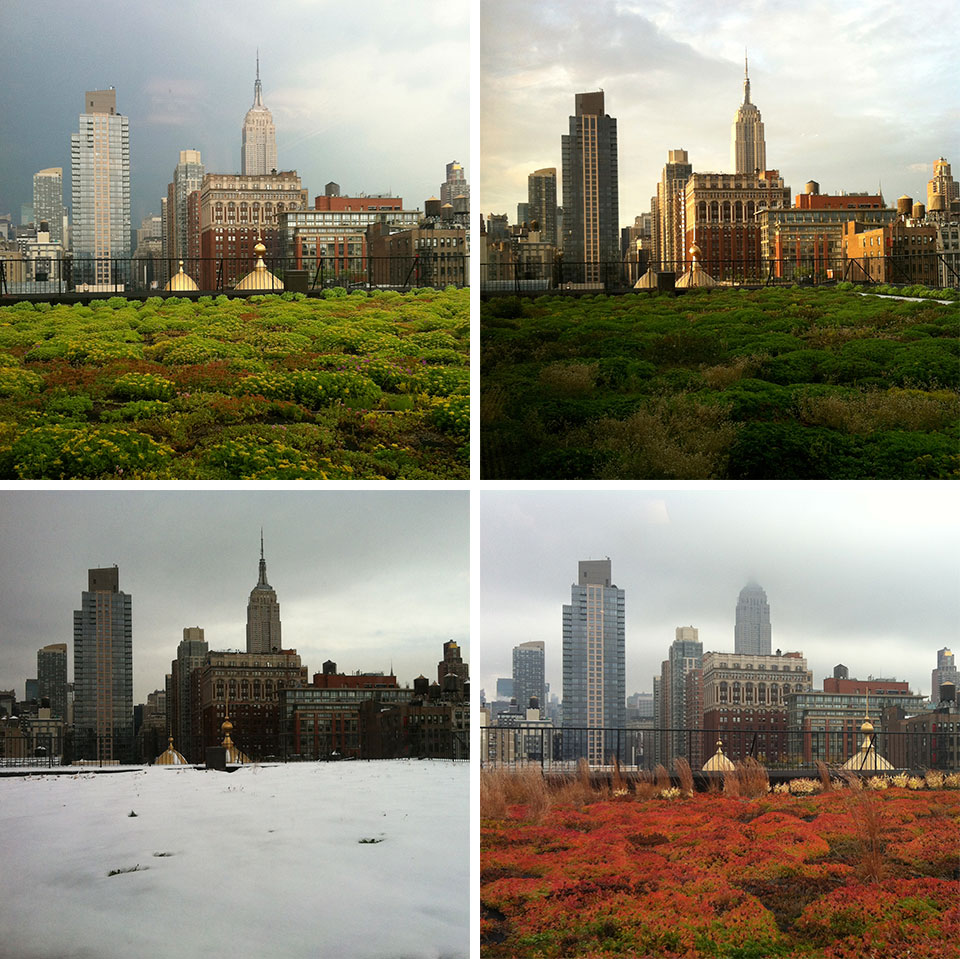
Relation to other Patterns
Common overlaps:
- [P1] Visual Connection with Nature
- [P2] Non-Visual Connection with Nature
- [P3] Non-Rhythmic Sensory Stimuli
- [P5] Presence of Water
-
and sometimes also:
[P4] Thermal & Airflow Variability - [P6] Dynamic & Diffuse Light
- [P13] Mystery
Outside the New York penthouse office of COOKFOX Architects, sits a 3,000 square foot extensive green roof that changes color and vibrancy from season to season. Witnessing a hawk killing a small bird shifted employee perception of their green roof as an ecosystem and not just a decorative garden. This perception was reinforced when employees noticed changes in bee colony behavior during times of extreme heat and humidity, when the honeybee apiary was invaded by robber bees, and again when the summer honey harvest looked and tasted different than the autumn harvest.

4.2 Natural Analogues
link to this sectionThe Experience
A space with good Biomorphic Forms & Patterns feels interesting and comfortable, possibly captivating, contemplative or even absorptive.
Roots of the Pattern
Biomorphic Forms & Patterns has evolved from research on view preferences (Joye, 2007), reduced stress due to induced shift in focus, and enhanced concentration. We have a visual preference for organic and biomorphic forms but the science behind why this is the case is not yet formulated. While our brain knows that biomorphic forms and patterns are not living things, we may describe them as symbolic representations of life (Vessel, 2012).
Examples
Decor:
- Fabrics, carpet, wallpaper designs based on Fibonacci series or Golden Mean
- Window details: trim and moldings, glass color, texture, mullion design, window reveal detail
- Installations and free-standing sculptures
- Furniture details
- Woodwork, masonry
- Wall decal, paint style or texture
Form / Function:
- Arrangement of the structural system (e.g., columns shaped like trees)
- Building form
- Acoustic paneling (wall or ceiling)
- Railings, banisters, fencing, gates
- Furniture form
- Window details: frit, light shelves, fins
- Pathway and hallway form
Nature abhors right angles and straight lines; the Golden Angle, which measures approximately 137.5 degrees, is the angle between successive florets in some flowers, while curves and angles of 120 degrees are frequently exhibited in other elements of nature (e.g., Thompson, 1917).
The Fibonacci series (0, 1, 1, 2, 3, 5, 8, 13, 21, 34...) is a numeric sequence that occurs in many living things, plants especially. Phyllotaxy, or the spacing of plant leaves, branches and flower petals (so that new growth doesn't block the sun or rain from older growth) often follows in the Fibonacci series. Related to the Fibonacci series is the Golden Mean (or Golden Section), a ratio of 1:1.618 that surfaces time and again among living forms that grow and unfold in steps or rotations, such as with the arrangement of seeds in sunflowers or the spiral of seashells.
Biomorphic forms and patterns have been artistically expressed for millennia, from adorning ancient temples to more modern examples like Hotel Tassel in Brussels (Victor Horta, 1893) and the structures of Gare do Oriente in Lisbon (Santiago Calatrava, 1998). More intriguing still is the architectural expression of mathematical proportions or arrangements that occur in nature, the meaning of which has been fodder for philosophical prose since Aristotle and Euclid. Many cultures have used these mathematical relationships in the construction of buildings and sacred spaces. The Egyptian Pyramids, the Parthenon (447-438 BC), Notre Dame in Paris (beginning in1163), the Taj Mahal in India (1632–1653), the CN Tower in Toronto (1976), and the Eden Project Education Centre in Cornwall, UK (2000) are all alleged to exhibit the Golden Mean.
Working with the Pattern
The objective of Biomorphic Forms & Patterns is to provide representational design elements within the built environment that allow users to make connections to nature. The intent is to use biomorphic forms and patterns in a way that creates a more visually preferred environment that enhances cognitive performance while helping reduce stress.
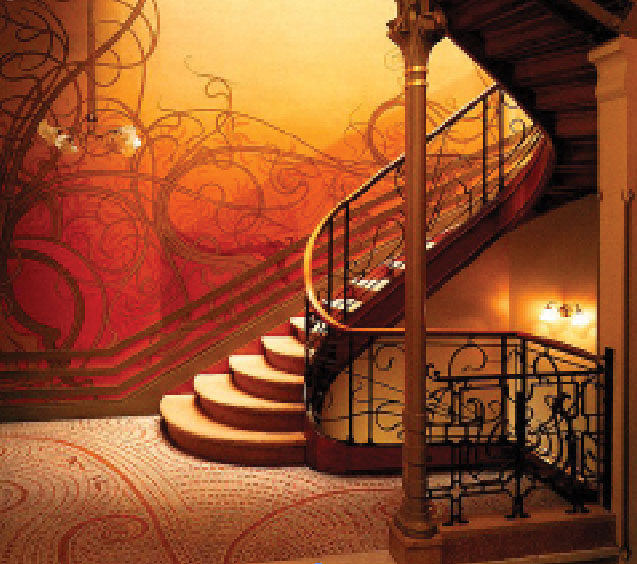
The organic and curvaceous stairs, mosaics, railings, light fixtures, window details and other decorative elements of the Hotel Tassel in Brussels, by Victor Horta are a classic example of Biomorphic Forms & Patterns.
Humans have been decorating living spaces with representations of nature since time immemorial, and architects have long created spaces using elements inspired by trees, bones, wings and seashells. Many classic building ornaments are derived from natural forms, and countless fabric patterns are based on leaves, flowers, and animal skins. Contemporary architecture and design have introduced more organic building forms with softer edges or even biomimetic qualities.
There are essentially two approaches to applying Biomorphic Forms & Patterns, as either a cosmetic decorative component of a larger design, or as integral to the structural or functional design. Both approaches can be utilized in tandem to enhance the biophilic experience.
Design considerations that may help create a quality biomorphic condition:
- Apply on 2 or 3 planes or dimensions (e.g., floor plane and wall; furniture windows and soffits) for greater diversity and frequency of exposure.
- Avoid the overuse of forms and patterns that may lead to visual toxicity.
- More comprehensive interventions will be more cost effective when they are introduced early in the design process.
Relation to other Patterns
Common overlaps:
- [P1] Visual Connection with Nature
- [P10] Complexity & Order
The Art Nouveau Hotel Tassel in Brussels (Victor Horta, architect, 1893) is a favorite example of Biomorphic Forms & Patterns. The interior space in particular is rife with natural analogues, with graphic vine-like tendrils painted on the wall and designed into the banisters and railings, floor mosaics, window details, furniture, and columns. The curvaceous tiered steps seem to make distant reference to shells or flower petals.

The Experience
A space with a good Material Connection with Nature feels rich, warm and authentic, and sometimes stimulating to the touch.
Roots of the Pattern
While scientific documentation on the health impact of natural materials is limited, available research is beginning to shed light on opportunities for informed design. As such, the Material Connection with Nature pattern has evolved from a limited body of scientific research on physiological responses to variable quantities of natural materials, and the impact of natural color palette, particularly the color green, has on cognitive performance.
Examples
Decor:
- Accent details (natural wood grains; leather; stone, fossil textures; bamboo, rattan, dried grasses)
- Interior surfaces (veneer, countertops)
- Woodwork, stonework
- Natural color palette, particularly greens
Form / Function:
- Wall construction (wood, stone)
- Structural systems (heavy timber beams)
- Façade material
- Furniture form
- Footpaths, bridges
One such study demonstrated that a difference in wood ratio on the walls of an interior space led to different physiological responses (Tsunetsugu, Miyazaki & Sato, 2007). The researchers observed that a room with a moderate ratio of wood (i.e., 45% coverage), with a more subjective "comfortable" feeling, exhibited significant decreases in diastolic blood pressure and significant increases in pulse rate, whereas a decrease in brain activity was observed in large ratios (i.e., 90% coverage), which could be either highly restorative in a spa or doctor's office, or counterproductive if in a space where high cognitive functionality is expected.
In a series of four experiments examining the effect of the presence of the color green on the psychological functioning of participants, the results concluded that exposure to the color green before conducting a task "facilitates creativity performance, but has no influence on analytical performance" (Lichtenfeld et al., 2012). Humans are also able to distinguish more variations in the color green than of any other color (Painter, 2014). However, which variation(s) of the color green most influence creativity or other mind-body responses is not well understood.
Working with the Pattern
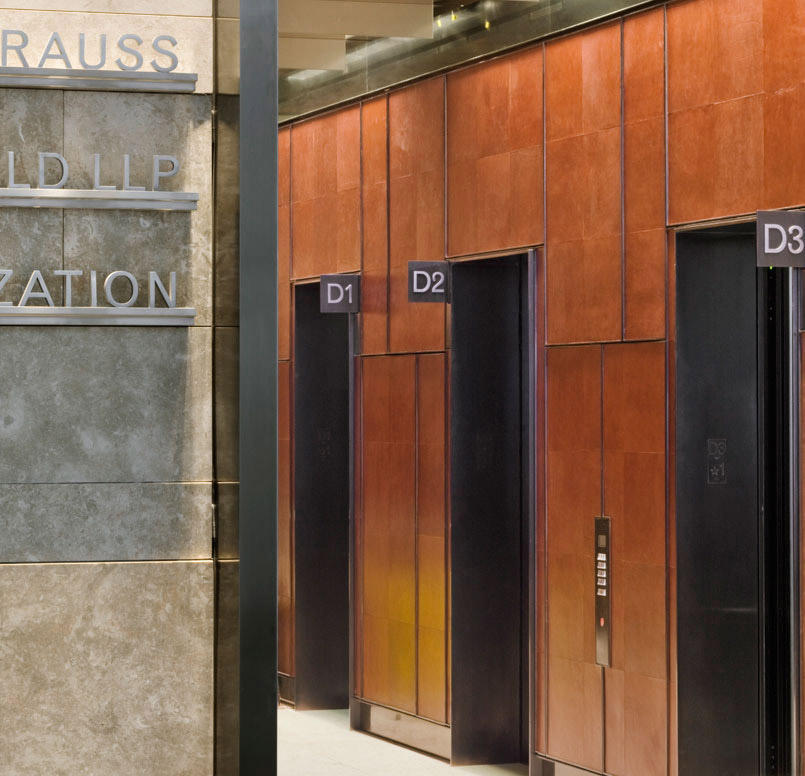
Leather clad elevator lobby of the Bank of America Tower in New York by CookFox Architects visually warms the space.
The objective of the Material Connection with Nature pattern is to explore the characteristics and quantities of natural materials optimal for engendering positive cognitive or physiological responses. In some cases, there may be several layers of information in materials that enhance the connection, such as learned knowledge about the material, familiar textures, or nested fractals that occur within a stone or wood grain pattern.
Natural materials can be decorative or functional, and are typically processed or extensively altered (e.g., wood plank, granite countertop) from their original 'natural' state, and while they may be extracted from nature, they are only analogous of the items in their 'natural' state.
Design considerations that may help create a quality material connection:
- Quantities of a (natural) material and color should be specified based on intended function of the space (e.g., to restore versus stimulate). In the same vein, a degree of variability of materials and applications is recommended over high ratios of any one material or color.
- Real materials are preferred over synthetic variations because human receptors can tell the difference between real and synthetic, so minimally processed materials from real nature are preferred whenever possible.
- Incorporating instances of the color green may help enhance creative environments; however, scientific studies on the impact of the color green have mostly been conducted in controlled lab environments, so dependence on color to engender creativity should be considered experimental.
Relation to other Patterns
Common overlaps:
- [P1] Visual Connection with Nature
- [P2] Non-Visual Connection with Nature
- [P8] Biomorphic Forms & Patterns
- [P10] Complexity & Order
The lobby of the Bank of America Tower at One Bryant Park in New York (COOKFOX Architects, 2009) is a good example of a diverse application of Material Connections with Nature. One enters the glass skyscraper by grasping a thin wooden door handle. The interior lobby walls are clad with Jerusalem Stone – the tiles with the highest fossil content were intentionally placed at the corner where they would be most encountered and even touched by passersby. Leather paneling in the elevator lobby is warm in color, providing a sense of calm for people as they wait for their ride, and soft to the touch, from which the patina has begun to show.

The Experience
A space with good Complexity & Order feels engaging and information-rich, as an intriguing balance between boring and overwhelming.
Roots of the Pattern
The Complexity & Order pattern has evolved from research on fractal geometries and preferred views; the perceptual and physiological responses to the complexity of fractals in nature, art and architecture; and the predictability of the occurrence of design flows and patterns in nature.[P10 Endnote ]
Research has repeatedly confirmed correlations between fractal geometries in nature and those in art and architecture (e.g., Joye, 2007; Taylor, 2006), but there are opposing opinions about which fractal dimension is optimal for engendering a positive health response, whether an optimal ratio exists, or if such a ratio is even important to identify as a design metric or guideline. Nikos Salingaros (2012) has examined a series of these perspectives with great clarity, noting that the range of preferred fractal dimensions is potentially quite broad (D=1.3-1.8) depending on the application.
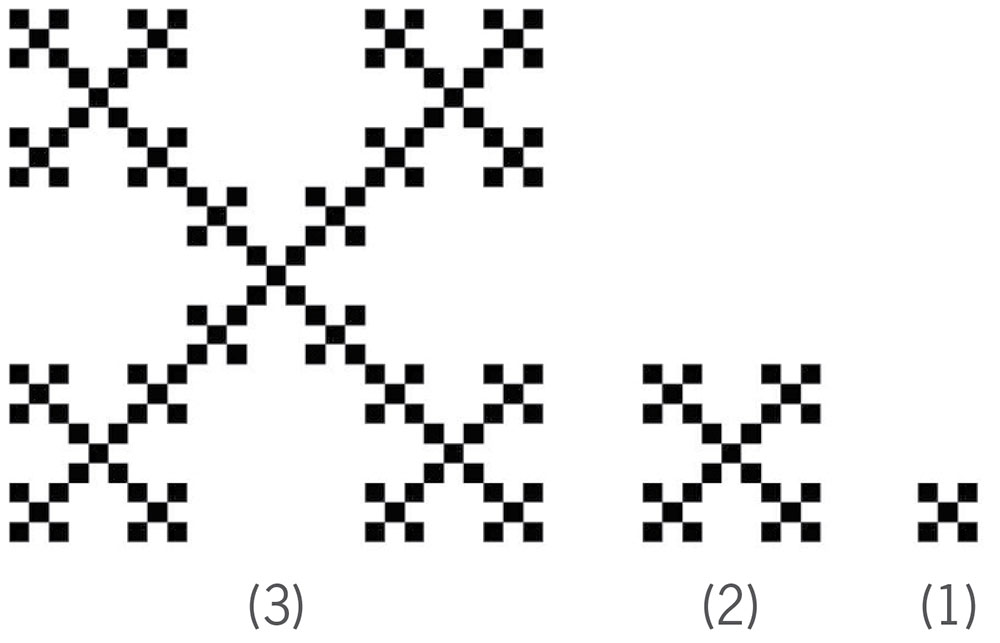
A square () with a scaling factor of 3 is more impactful than to a factor of 2.
Nested fractal designs expressed as a third iteration of the base design (i.e., with scaling factor of 3) are more likely to achieve a level of complexity that conveys a sense of order and intrigue, and reduces stress (Salingaros, 2012), a quality lost in much of modern architecture, which tends to limit complexity to the second iteration, and consequently results in an arguably dull and inadequately nurturing form that fails to stimulate the mind or engender physiological stress reduction.
At either end of the spectrum, both non-fractal artwork and high-dimensional fractal artwork have been shown to induce stress (Hägerhäll et al., 2008; Taylor, 2006). Overly complex designs and environments may result in psychological stress and even nausea. According to Judith Heerwagen and Roger Ulrich, occupants in a US Navy office in Mississippi reported nausea, headaches and dizziness, symptoms frequently associated with poor indoor air quality or poor ventilation. It was determined that the interaction of multiple wall paper patterns, complex patterns in carpets and moiré patterns in seating fabrics caused surfaces to appear to move as occupants walked through the space and therefore caused extreme visual perception problems (Heerwagen, personal communication, March 2014).
Examples
Decor:
- Wallpaper and carpet design
- Material texture and contour
- Window details: trim and moldings, glass color, texture, mullion design, window reveal detail
- Plant selection variety and placement
- Complex plant oil fragrances
- Auditory stimuli
Form / Function:
- Exposed structure/exoskeleton
- Exposed mechanical systems
- Façade materials
- Façade, spandrel and window hierarchy
- Building skyline
- Floor plan, landscape plan, urban grid
- Pedestrian and traffic flows
- Resource flows
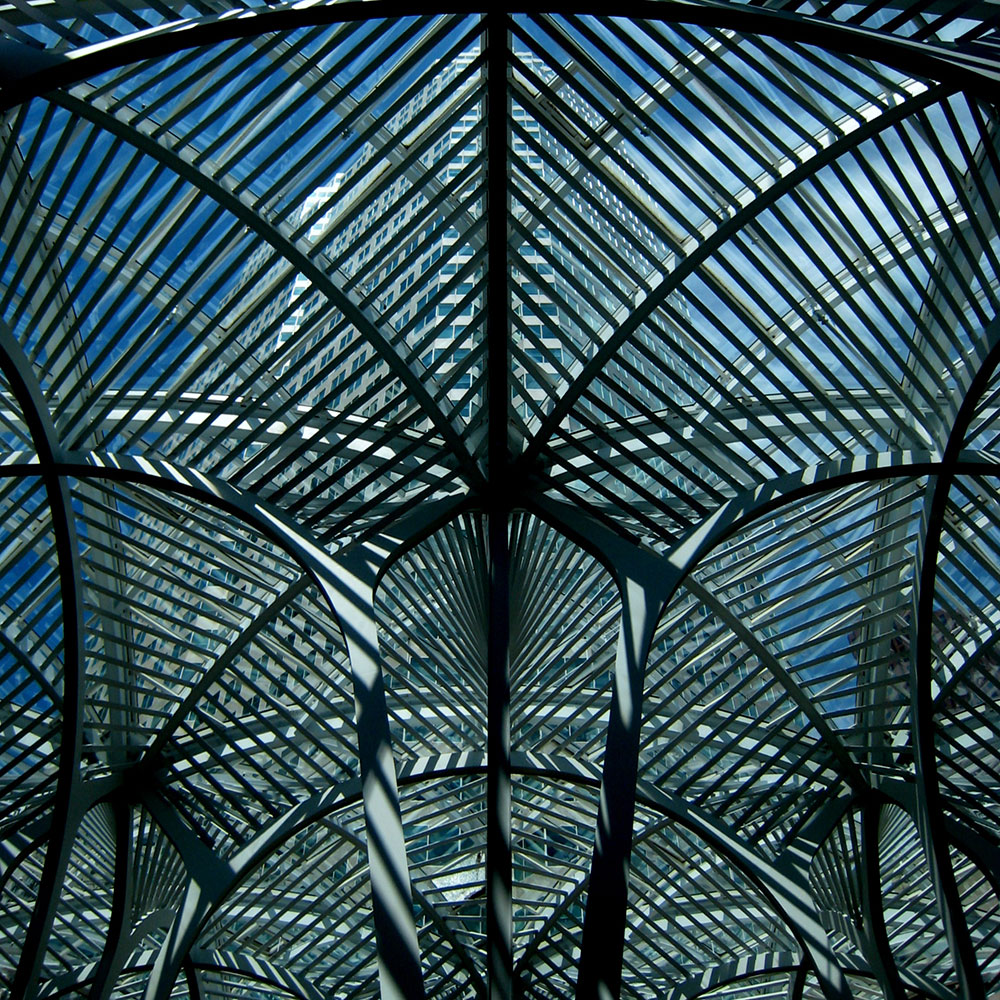
The engaging ceiling structure of the Allen Lambert Galleria and Atrium at Brookfield Place by Santiago Calatrava in Toronto.
Fractal patterns can be identified in classical art and vernacular architecture from the column capitals of ancient Greece and Egypt, the art of Ancient Mayans, Islamic and Egyptian art, Hindu temples, Angkor Wat in Cambodia (12th century), and the Eiffel Tower in Paris (1889). Fractals are also evident in such well-known works as those of Botticelli, Vincent van Gogh, and Jackson Pollock.
Working with the Pattern
The objective of the Complexity & Order pattern is to provide symmetries and fractal geometries, configured with a coherent spatial hierarchy, to create a visually nourishing environment that engenders a positive psychological or cognitive response (Salingaros, 2012).
Fractals can exist at any scale, from desktop trinkets or textile patterns, to façade design, to a city grid or regional transport infrastructure. Scenes in nature typically support multiple fractal dimensions – savanna landscapes often support mid-range fractal dimensions – so there are potentially many opportunities to incorporate fractals.
A familiar challenge in the built environment is in identifying the balance between an information rich environment that is interesting and restorative, and one with an information surplus that is overwhelming and stressful. Targeting an optimal dimensional ratio for design applications can be problematic (i.e., time consuming, inconsistent and even inaccurate), of questionable long-term value, and essentially less important than the incorporation of third-iteration fractal designs. As Salingaros (2012) points out, identifying precise fractal geometries in existing naturescapes, structures and artworks is a challenge, whereas generating new works with complex fractals is quite easy, so specifying fractal artwork, for instance, may not always be the most efficient use of project resources.
Design considerations that may help create a quality Complexity & Order condition:
- Prioritize artwork and material selection, architectural expressions, and landscape and master planning schemes that reveal fractal geometries and hierarchies.
- Fractal structures with iterations of three will be more impactful than a design limited to two iterations.
- Computer technology using the algorithms of mathematical and geometric functions can produce fractal designs for architectural, design and planning applications with ease. If a fractal design is being created, consider using geometries with a mid-range dimensional ratio (broadly speaking, D=1.3-1.75).
- Over-use of and/or extended exposure to high-fractal dimensions could instill discomfort or even fear, countering the intended response: to nourish and reduce stress. Avoidance or under-utilization of fractals in design could result in complete predictability and disinterest.
- A new building or landscape design should take into account its impact on the fractal quality of the existing urban skyline.
Relation to other Patterns
Common overlaps:
- [P1] Visual Connection with Nature
- [P2] Non-Visual Connection with Nature
- [P8] Biomorphic Forms & Patterns
- [P9] Material Connection with Nature
Tucked in between buildings of downtown Toronto, Ontario, is the Allen Lambert Galleria and Atrium at Brookfield Place. The cathedral-like in structure designed by Santiago Calatrava (1992) is information rich, yet protecting, with its orderly columns that rise up into a canopy of complex tree-like forms, showers diffuse light and shadow onto the courtyard, and keeps visitors awestruck and engaged.

4.3 Nature of the Space
link to this sectionThe Experience
A space with a good Prospect condition feels open and freeing, yet imparts a sense of safety and control, particularly when alone or in unfamiliar environments.
Roots of the Pattern
The Prospect pattern has evolved from research on visual preference and spatial habitat responses, as well as cultural anthropology, evolutionary psychology and architectural analysis. Health benefits are suggested to include reductions in stress, boredom, irritation, fatigue and perceived vulnerability, as well as improved comfort [P11 Endnote ].
In evolutionary psychology terms, we should prefer habitats that are similar to the African savannas on which we evolved as a species. This becomes clear in visual preference research starting with Jay Appleton's Experience of Landscape in 1975, where he asked why certain views from the same vantage point are preferred over others. Wilson and Kellert (1993) argue that our view preferences, and possibly our aesthetic preferences, have roots in referential points that benefit our survival. For example, flowers are indicators of healthy plant growth, and to signal the availability of resources in the future (Orians & Heerwagen, 1992). The savanna, with its open terrain and copses of shade trees, becomes more favorable when combined with water, an understory of flowers and forbs, calm grazing animals and evidence of human habitation. That we should be genetically predisposed to prefer this scene is posited by the Savanna Hypothesis (Orians & Heerwagen, 1986 and 1992).
Examples
Decor:
- Focal lengths ≥ 20 feet (6 meters)
- Partition heights ≤ 42 inches (hedges; opaque workplace partitions)
Form / Function:
- Transparent materials
- Balconies, catwalks, staircase landings
- Open floor plans
- Elevated planes
- Views including shade trees, bodies of water or evidence of human habitation
Distant prospect (>100 feet, >30 meters) is preferred over shorter focal lengths (<20 feet, 6 meter) because it provides a greater sense of awareness and comfort (Herzog & Bryce, 2007), reducing one's stress responses, particularly when alone or in unfamiliar environments (Petherick, 2000). Good Prospect is extensive and information rich, with a savanna-like view.
Working with the Pattern
The objective of the Prospect pattern is to provide users with a condition suitable for visually surveying and contemplating the surrounding environment for both opportunity and hazard. In landscapes, prospect is characterized as the view from an elevated position or across an expanse. While an elevated position can enhance (indoor and outdoor) prospect, it is not essential to creating a quality Prospect experience.
There are potentially endless combinations for applying characteristics of Prospect (Dosen & Ostwald, 2013). There is interior prospect, exterior prospect, as well as short depth and high depth prospect that can occur simultaneously. The complexity and variety of ways to achieve prospect is what makes it such a powerful design element. For interior spaces or dense urban spaces, prospect is the ability to see from one space to another, and is strengthened when there are clear distinctions and the opportunity to see through multiple spaces (Hildebrand, 1991).
Design considerations that may help create a quality Prospect condition:
Relation to other Patterns
Complementary patterns:
- [P1] Visual Connection with Nature
- [P5] Presence of Water
- [P12] Refuge
- [P13] Mystery
- [P14] Risk/Peril
- Orienting building, fenestration, corridors and workstations will help optimize visual access to indoor or outdoor vistas, activity hubs or destinations.
- Designing with or around an existing or planned savanna-like ecosystem, body of water, and evidence of human activity or habitation will help the information-richness of the prospect view.
- Providing focal lengths of ≥20 feet (6 meters), preferably 100 feet (30 meters); when a space has sufficient depth, spatial properties can be leveraged to enhance the experience by removing visual barriers. Limiting partition heights to 42" will provide spatial barriers while allowing seated occupants to view across a space. Understory vegetation or hedges should use a similar guide; preferred height limitations will depend on terrain and how the space is most experienced (e.g., while sitting, standing, on a bicycle).
- Locating stairwells at building perimeter with glass façade and interior glass stairwell walls can form a dual Prospect condition.
- When high ceilings are present, perimeter or interior spaces elevated 12-18" will enhance the Prospect condition.
- Often the view quality and the balance between Prospect and [P12] Refuge will be more important than the size or frequency of the experience.
- Refer to [P1] Visual Connection with Nature to optimize the Prospect experience with a quality view.
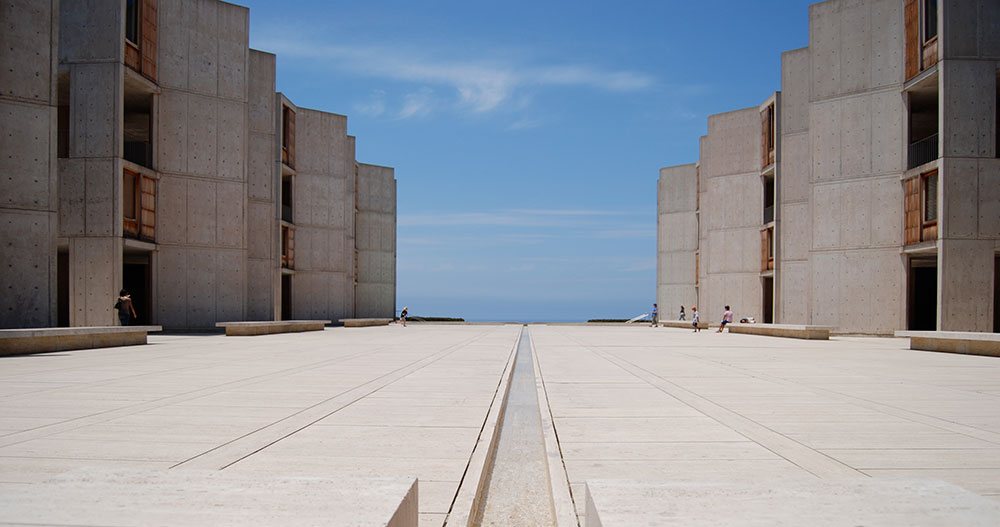
The central courtyard of the Salk Institute for Biological Studies in California, designed by Louis Kahn, is a popular example of a nearly pure Prospect condition. This elevated space is bounded by the angled fins of the adjacent researcher offices, and has a rill flowing through the center out towards the view of the Pacific Ocean. There are some small trees in planters at the entry of the courtyard, but once in the space one's gaze is drawn outward through the space.

The Experience
A space with a good Refuge condition feels safe, providing a sense of retreat and withdrawal – for work, protection, rest or healing – whether alone or in small groups. A good refuge space feels separate or unique from its surrounding environment; its spatial characteristics can feel contemplative, embracing and protective, without unnecessarily disengaging.
Roots of the Pattern
The Refuge pattern has evolved from research on visual preference research and spatial habitat responses, and its relationship to [P11] Prospect conditions. Refuge conditions are important for restoration experiences and stress reduction, which can be realized through lowered blood pressure and heart rate. Other benefits of Refuge are suggested to include reduced irritation, fatigue and perceived vulnerability, as well as improved concentration, attention and perception of safety (Grahn & Stigsdotter, 2010; Wang & Taylor, 2006; Petherick, 2000; Ulrich et al., 1993).
Jay Appleton's writing (1975, 1996) is focused on theory and is a good overall reference for both Prospect and Refuge, whereas Grant Hildebrand (1991) has written the most intelligently about Prospect and Refuge in the built environment and is a good reference for applications. In Grant Hildebrand's words, "The edge of a wood is one of the most prevalent of natural prospect-refuge conjunctions" for it provides protection from weather and predators, but allows for outward surveillance. Nonetheless, the health response to Refuge is reportedly stronger than the response to Prospect, and the compounded response is enhanced when the two spatial conditions converge (Grahn & Stigsdotter, 2010).
Example characteristics
Spatial Attributes:
- Modular refuge: Small protection (high-back chair, overhead trellis)
- Partial refuge: Several sides covered (reading nooks, booth seating, bay window seats, canopy beds, gazebos, canopy trees, arcades, covered walkways or porches)
- Extensive refuge: near or complete concealment (reading/telephone/sleeping pods, meeting rooms with 3+ walls, private offices, tree houses)
Common Features:
- Spaces with weather/climate protection, or speech and visual privacy
- Spaces reserved for reflection, meditation, rest, relaxation, reading, or complex cognitive tasks
- Operable, adjustable or translucent (or semi-opaque) shades, blinds, screens or partitions
- Drop or lowered ceiling or soffit, overhang or canopy
- Lowered or varied light color, temperature or brightness
In small urban parks, park size is less important than the ability to be immersed in the space with the conditions of enclosure leading to restoration (e.g., Nordh, Hartig, Hägerhäll & Fry, 2009). In larger parks, the refuge spaces under trees, and in vegetation bordering an open space or meadow, are the preferred locations (e.g., Ruddell & Hammitt, 1987). Though science has yet to establish metrics for frequency or duration of access to refuge conditions, the balance between Refuge and Prospect is suggested to be more important than the size or frequency of the experience (Appleton, 1996).
Working with the Pattern
The primary objective of the Refuge pattern is to provide users with an easily accessible and protective environment – a smaller portion of a larger space – that supports restoration. The secondary objective is to limit visual access into the refuge space. The principal spatial condition is protection overhead and to one's back, preferably on three sides; strategic placement or orientation of the space can also influence quality of experience.
Common functions of Refuge conditions:
- weather or climate protection
- speech or visual privacy
- reflection or meditation
- rest or relaxation
- reading
- complex cognitive tasks
- protection from physical danger
In most cases, the refuge is not entirely enclosed, but rather provides some contact (visual or aural) with the surrounding environment for surveillance. The greater the number of protective sides, the greater the refuge condition; however, complete refuge – protection on all sides – is not necessarily the most appropriate or effective solution, as it does not maintain a relationship to the larger space. The traditional lean-to is a great example of basic refuge, as are a cozy bench seat in a bay window of the kitchen or a fireside inglenook.
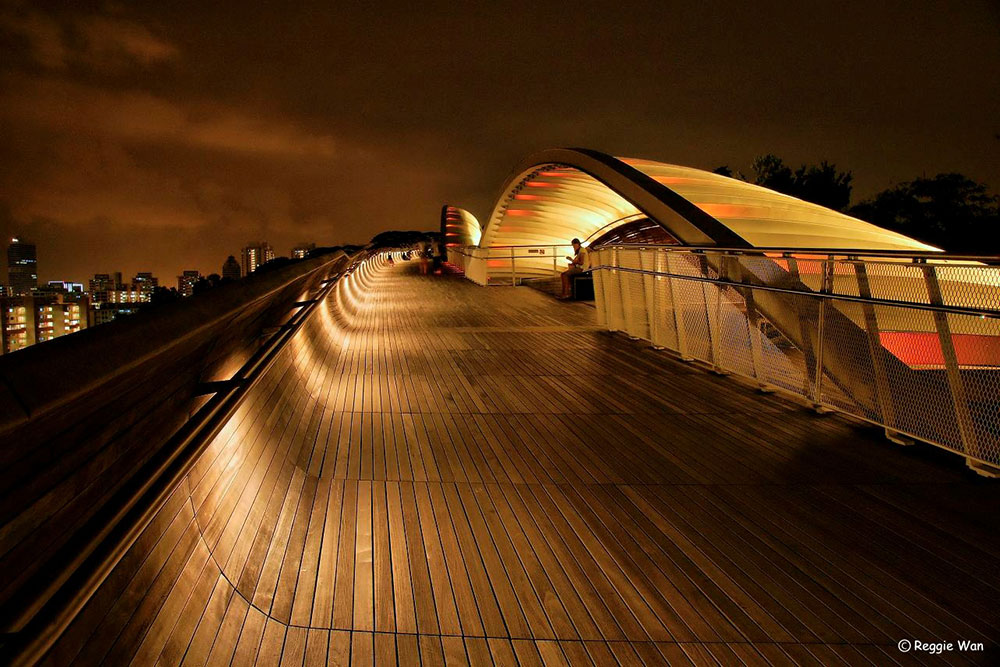
Protected seating alcoves along the Henderson Bridge, Singapore provide a sense of refuge.
Refuge spaces take many forms, so understanding the context and defining the intended user experience will certainly influence design decisions. There are endless combinations of design elements that can create a quality refuge space that offers shade or protection from natural or man-made environmental conditions.
Design considerations:
- Indoor refuge spaces are usually characterized by lowered ceiling conditions. For spaces with standard ceiling heights, this may equate to approximately 18-24 inches below the main ceiling, and is often achieved through treatments like a soffit, a drop-ceiling or acoustical paneling, or suspended fabric.
- For outdoor or indoor spaces with particularly high ceilings (>14 feet), a more drastic differential may be necessary to achieve the desired outcome; freestanding or vegetative alcoves and mezzanine-like structures are often effective.
- When designing for larger populations or multiple activity types, providing more than one kind of refuge space can address varying needs, which can often be met through differing spatial dimensions, lighting conditions, and degree of concealment.
- Light levels in refuge spaces should differ from adjacent spaces and user lighting controls will broaden functionality as a refuge space.
Relation to other Patterns
Complementary patterns:
- [P4] Thermal & Airflow Variability
- [P6] Dynamic & Diffuse Light
- [P11] Prospect
- [P13] Mystery
Sitting with one's back against the trunk of a big shade tree is a classic refuge space, as is high backed booth seating in a restaurant, a reading nook in a library or school, a covered bus stop, or a wraparound porch. Treehouses are a timeless example of Refuge; and Cliff Palace in Mesa Verde, Colorado (constructed pre-A.D.1200s) is one of the best historic examples. While the settlement provides a feeling of containment and protection from the arid climate and potential predators or enemies, the refuge experience is enhanced with characteristics of Prospect through its elevated position and views over the canyon.

The Experience
A space with a good Mystery condition has a palpable sense of anticipation, or of being teased, offering the senses a kind of denial and reward that compels one to further investigate the space.
Roots of the Pattern
The Mystery pattern is largely based on the idea that people have two basic needs in environments: to understand and to explore (Kaplan & Kaplan, 1989) and that these 'basic needs' should occur "from one's current position" in order to engender a sense of mystery (Herzog and Bryce, 2007).
The Mystery pattern has evolved from research on visual preference and perceived danger, as well as pleasure responses to anticipatory situations. Mystery engenders a strong pleasure response within the brain that may be a similar mechanism to that of anticipation, which is hypothesized to be an explanation for why listening to music is so pleasurable – in that we are guessing what may be around the corner.[P13 Endnote ] The benefits of mystery conditions are suggested to include improved preference for a space; heightened curiosity; increased interest in gaining more information and greater likelihood of encountering other biophilic conditions.
A quality mystery condition does not engender a fear response; the conditions that differentiate between surprise (i.e., fear) and pleasure center around the visual depth of field. An obscured view with a shallow depth of field has shown to lead to unpleasant surprises, whereas greater visual access, with a medium (≥20 ft) to high (≥100 ft) depth of field is preferred (Herzog and Bryce, 2007).
A good mystery condition could also be expressed through the obscuring of the boundaries and a portion of the focal subject (i.e., room, building, outdoor space, or other information source), thereby enticing the user to anticipate the full extent of the subject and explore the space further (Ikemi, 2005).
Working with the Pattern
Example characteristics
Spatial Attributes:
- Views are medium (≥ 20 ft) to high (≥ 100 ft) depth of field
- At least one edge of the focal subject is obscured, preferably two edges
- Auditory stimulation from an imperceptible source
- Peek-a-boo windows that partially reveal
- Curving edges
- Winding paths
Common Features:
- Light and shadow
- Sound or vibration
- Scent
- Activity or movement
- Artwork or installation
- Form and flow
- Translucent materials
Mystery characterizes a place where an individual feels compelled to move forward to see what is around the corner; it is the partially revealed view ahead. The objective of the Mystery pattern is to provide a functional environment that encourages exploration in a manner that supports stress reduction and cognitive restoration. While other 'Nature of the Space' patterns can be experienced in a stationary position, mystery implies movement and analysis starting from a place perceived in a fundamentally positive way.
Mystery conditions have their place among indoor and outdoor plazas, corridors, pathways, parks, and other transitory spaces. The sense of mystery can be diluted over time and with routine exposure; however, strategies that include revolving content or information, such as peek-a-boo windows into common areas where activity is constantly changing, will be most effective in spaces routinely occupied by the same group of people.
Design considerations that will help create a quality Mystery condition:
- Curving edges that slowly reveal are more effective than sharp corners in drawing people through a space.
- Dramatic shade and shadows can enhance the mystery experience.
- Strategies that provide dark shadows or shallow depth of field could instill unappreciated surprise or fear.
- The speed at which users are transiting through a space will influence both the size of the aperture and the size of the subject; faster typically means bigger.
- Organically evolved mystery conditions (e.g., low maintenance gardens with winding paths) are expectedly going to change characteristics over time. These changes should be monitored as they may enhance the mystery condition, or otherwise degrade it as it evolves into a surprise condition (e.g., overgrowth of plantings leads to obscuring of depth of field).
Relation to other Patterns
Common overlaps:
- [P1] Visual Connection with Nature
- [P2] Non-Visual Connection with Nature
- [P3] Non-Rhythmic Sensory Stimuli
- [P6] Dynamic & Diffuse Light
-
and sometimes also:
[P7] Connection with Natural Systems - [P10] Complexity & Order
- [P11] Prospect
- [P12] Refuge
This process of denial and reward, obscure and reveal is evident in Japanese garden design and various mazes and labyrinths throughout the world. The gardens at Katsura Imperial Villa, in Kyoto, Japan, make strong use of Mystery to draw visitors through the space and instill a sense of fascination. The strategic placement of buildings within the garden allows them to be hidden and slowly revealed at various points along the garden path, encouraging the user to explore further.
Prospect Park, in Brooklyn, New York, is an excellent example of Mystery. In classic Olmsted style, many views throughout the park are obscured through the use of topography and vegetation. Key focal points in the landscape are revealed from stationary prospect points within the park. The focal points within the park (trees, buildings, lake and meadows) give the space a degree of legibility, but obscured views entice occupants to explore the space further, in order to understand it, which cannot be achieved in a single visit.
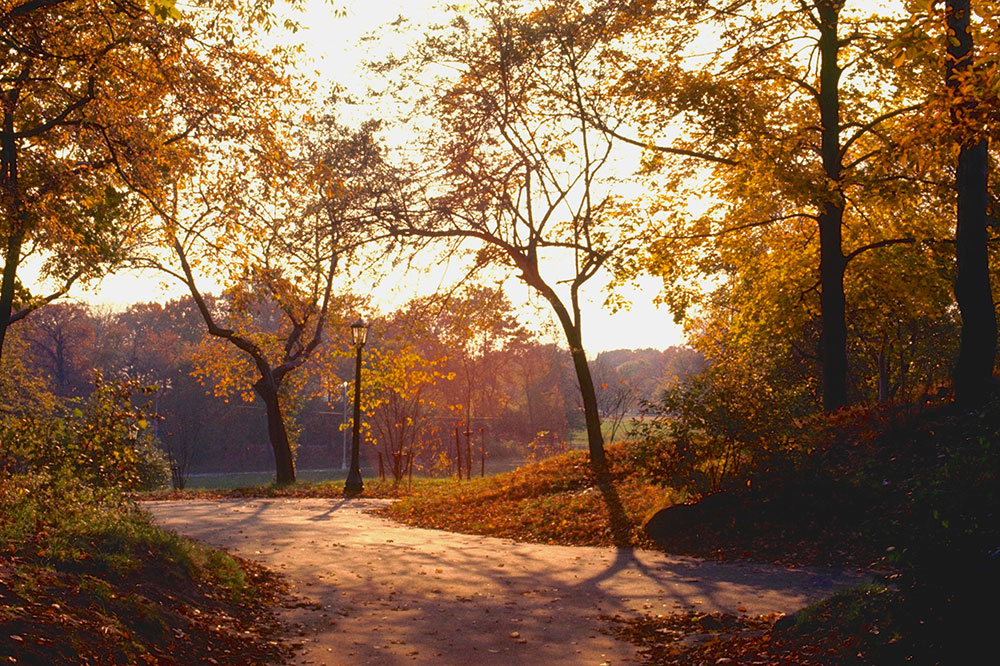

Example characteristics
Spatial Attributes:
- Heights
- Gravity
- Water
- Predator-prey role reversal
Perceived Risks
- Falling
- Getting wet
- Getting hurt
- Loss of control
Common Features:
- Double-height atrium with balcony or catwalk
- Architectural cantilevers
- Infinity edges
- Façade with floor-to-ceiling transparency
- Experiences or objects that are perceived to be defying or testing gravity
- Transparent railing or floor plane
- Passing under, over or through water
- Proximity to an active honeybee apiary or predatory animals
- Life-sized photography of spiders or snakes
The Experience
A space with a good Risk/Peril condition feels exhilarating, and with an implied threat, maybe even a little mischievous or perverse. One feels that it might be dangerous, but intriguing, worth exploring and possibly even irresistible.
Roots of the Pattern
Risk can be generated by a learned or biophobic response triggered by a near and present danger. This danger, however, is inert and unable to cause harm due to a trusted element of safety. The defining difference between Risk/Peril and fear is the level of perceived threat and perceived control (Rapee, 1997).
Having an awareness of a controllable risk can support positive experiences that result in strong dopamine or pleasure responses. These experiences play a role in developing risk assessment during childhood. In adults, short doses of dopamine support motivation, memory, problem solving and fight-or-flight responses; whereas, long-term exposure to intense Risk/Peril conditions may lead to over-production of dopamine, which is implicated in depression and mood disorders.[P14 Endnote ]
Working with the Pattern
The objective of the Risk/Peril pattern is to arouse attention and curiosity, and refresh memory and problem solving skills. There are different degrees of risk that can be incorporated into a design depending on the intended user or the space available; a cantilevered walkway over a sheer cliff is an extreme case; viewing a predator in a zoo exhibit may provide a greater sense of control; whereas, rock-hopping through a gentle water feature presents the risk of getting one's feet wet.
Design considerations that will help create a quality Risk/Peril condition:

The Levitated Mass at Los Angeles County Museum of Art. Michael Heizer, artist.
Relation to other Patterns
Common overlaps:
- [P1] Visual Connection with Nature
- [P5] Presence of Water
- [P11] Prospect
- Risk/Peril design interventions are usually quite deliberate and as such will not be appropriate for all user groups or places.
- Design strategies that rely on spatial conditions will be easier to implement when incorporated as early as concept design and schematic phases of the design process.
- The element of safety must protect the user from harm while still permitting the experience of risk.
At Frank Lloyd Wright's home, Taliesin, in Spring Green, Wisconsin, The Birdwalk is a thrilling narrow balcony that cantilevers out over the hillside. The Levitated Mass at Los Angeles County Museum of Art is an enormous boulder that spans over a pedestrian ramp, and under which visitors pass. The balancing act is seems improbable, but the bracing provides some reassurance of safety, and visitors flock en masse to be photographed below the rock.
Lower-level risk, like getting one's feet wet, may be a more appropriate strategy for some settings. A great example would the stepping stone path through the water feature designed by Herbert Dreiseitl at Potsdamer Platz in Berlin, Germany.

5. Final Thoughts
link to this section
"A new discipline needs to abstract its patterns as they appear. It is building its own foundation and logical skeleton, upon which future growth can be supported. Knowing its basic patterns early on will speed up the language's development, and guide it in the right direction."
The science supporting biophilic design is still emerging. In many ways, it could be argued that the research is really just corroborating the rediscovery of the intuitively obvious. Unfortunately, too much of our modern design is oblivious to this profound knowledge. Deep down, we know that the connection to nature is important. When asking people to think about their favorite places for vacation, the majority will describe some place outdoors; we use the term 'recreation' and forget that recreation is about recreating, restoring ourselves. So while empirical evidence is accumulating, we ought to go about restoring the human-nature connection in the built environment.
Just to remind ourselves why biophilic design is so important, consider that in the 12,000 years since humans began farming and other activities that transformed the natural landscape (Smithsonian, 2014), only in the last 250 years have modern cities become common. Within the last few years we became urban dwellers, with more people living in cities than in the countryside. In coming decades, it is projected that 70 percent of the world's population will live in cities. With this shift, the need for our designs to (re)connect people to an experience of nature becomes ever more important. Biophilic design is not a luxury, it's a necessity for our health and well-being.
We hope "14 Patterns of Biophilic Design" helps shed light both on the importance of the human connection with nature that are supported by biophilic design. We encourage people to challenge convention by bringing biophilic design patterns into a vision for healthy homes, workplaces and cities.
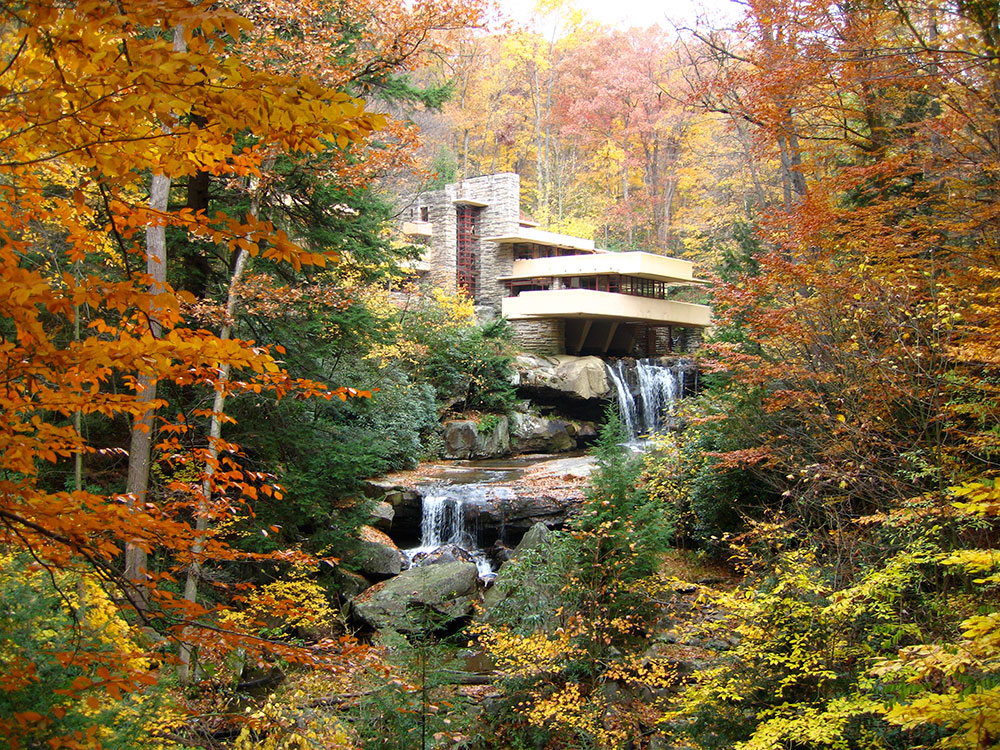
Appendix
6.1 Endnotes
link to this section"Perhaps we don't need such rigorous evidence when it comes to nature contact… Maybe we don't know everything there is to know about human benefits of nature contact, but we have a pretty fair idea, and we know a lot about designing nature into the built environment. And given the pace at which decisions are being made and places built, there is a pressing need to implement what we know. We can't wait for the research."
